Ars Magica: The Contested Isle by Mors Rattus
Ireland is Magic
Original SA post
A thread may be ending, but
I got a new Ars Magica book.
Ars Magica: The Contested Isle
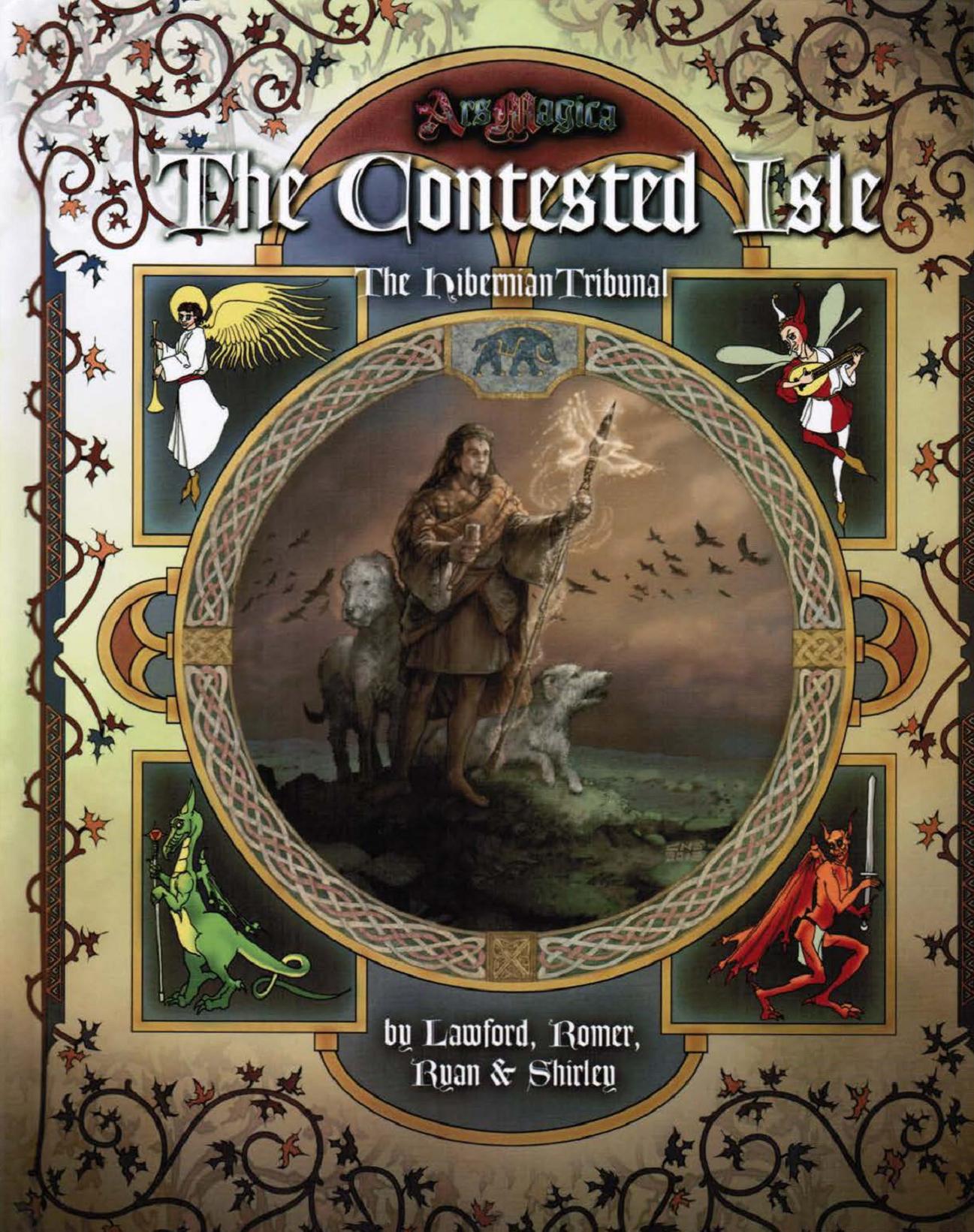
That's right! A new book! The Contested Isle is the latest Ars Magica book to be published. It focuses on the Hibernian Tribunal - that is, Ireland. (For those interested, the next book on the publishing schedule is Transforming Mythic Europe, which will be about wizards advancing the social and technological status of the world and how it might happen, as well as the potential consequences. How many other settings give you a book on how to utterly destroy the setting?)
As an overview: Ireland is fucking
loaded
with magic. It's all over the place. It is also full of violence. The English recently conquered the place, and the Tribunal is at a tipping point, as many factions push for power. The Irish don't band together well, though - they're as likely to raid each other as anyone else. The Tribunal's traditions, created by mostly Tytalus and Merinita, encourage rivalry and challenges, and relationships are complex. They fight each other, but protect the local hedge wizards, and have even given land over to them. But let's stop this overview and go in detail.
When the world was made, Ireland was only half-finished. It had forests, but no water, no animals, no meadows and no people. Five waves of settlers came to it before the current people, the Gaels or Milesians, depending on what name you prefer. These are known as the Five Peoples. They found the chaos of ancient Ireland, unformed, and they made it what it is now. The Irish have recorded this history as one seamless tale in several books, most famously the Lebor Gabala Erenn, the Book of the Taking of Ireland or the Book of Invaders. There is also the Lebor Laignech, the Book of Leinster, in the monastery of Tir-Da-Glas.
In any case, Ireland's first invaders were led by Cessair, granddaughter of Noah. Her grandfather ordered her to find a land untainted by human vice, and she hoped Ireland would be a safe haven from the Flood. It wasn't. Cessair and her people fled to the mountains of Ireland, but they drowned when the waters rose too high. Only one survived: Cessair's druid, Fionntan, who turned into a salmon. Legend has it that he had three other forms - stag, eagle and boar - and that he still lives today.
The second group left a greater mark. They were Greek, followers of the prince Partholon, and they brought with them art, craft and cattle. They cleared four great pastures from the primeval wood and saw the birth of four great lakes. They also found the Fomorach, monstrous giants from the northern islands. The Fomorach settled in the north and raided the Partholonian. Eventually, there was a grand battle, in which the tribe of Partholon killed the Fomorach, but in so doing, they doomed themselves. They left the giants' corpses on the field, and a plague came forth from them, killing all the tribe.
Third were Scythians, the tribe that followed the man Nemed. Nemed did not seek Ireland - he was just fleeing Scythia for fear of the punishment for his patricide. He and his tribe took a great fleet, following the sight of a great golden tower that rose from the sea to the west. This tower, built on an island, could be seen only at low tide, for at high tide, the waters covered it. After landing on the island, the tide took Nemed by surprise and destroyed most of the fleet. It was a year before the Nemedians saw land again, landing on Ireland by accident. They brought their soldiers, their families and their druids, bringing lore and craft to the wilderness. They cleared plains and saw lakes erupt forth for them, and their prosperity, like that of the Partholonians before them, brought the attention and greed of the Fomorach.
The Fomorach came from the northern oceans, capturing Nemed's tribe and demanding tribute. Nemed had died by this time, and his sons and grandsons suffered under Fomorach rule. The Nemedians plotted to rebel, sending to Greece for aid. The Greek king sent them soldiers, druids, druidesses, wolves and venomous beasts. With their aid, the Nemedians assaulted the Fomorach fortress on Tory Island, destroying it. Still, the victory was short-lived. Fomorach reinforcements attacked, and the Fomorach druids used terrible water magic to drown the battlefield, slaughtering the Nemedians and many of their own. At the end of the day, many of both sides lay dead, but the Fomorach had won, devastating their human foes. Three surviving grandsons of Nemed split their remaining followers into three groups, departing. The isle remained free of humans for two centuries.
Fourth to invade were the Fir Bolg. Legend has it that they descended from one of Nemed's grandsons, who was a slave in Greece before escaping and returning to Ireland. The tales of the Fir Bolg journey are grand, telling of epic battles against the dead and demons, but fail to tell how the Fir Bolg became Magical beings. 'Fir Bolg' means 'the men who swell with battle fury,' though some false believe it means 'men of the bag' because their Greek slavemasters made them move earth in leather bags. The Fir Bolg divided Ireland into provinces, invented kingship and justice and brought peace to the land. More on them much later.
The fifth invaders were the Tuatha De Danann, the last wave before the modern Gaels. After the Nemedians warred with the Fomorach, one of their groups started to worship Celtic faeries, who took the group to their mystical homeland in the north. In four fabled cities, the faerie Tuatha De taught their people culture, art and magic, interbreeding with them. When they returned to Ireland, the faerie gods came with them, as did their children and their druids. More on the Tuatha De Danann later.
In any case, the Fir Bolg and Fomorach ignored the requests for peace laid before them by the Tuatha De, seeking war. At the Battle of Moytirra, on the Plain of Cong in the province of Connacht, the Fir Bolg were defeated by the invaders, but in victory, the leader of the Tuatha De Danann lost an arm, making him unfit to rule. His chieftains chose a new leader, a son of Tuathe De mother and Fomoir father, in the hopes that it would keep the Fomorach at bay. It didn't. The Fomorach came and conquered the newcomers. However, at the Second Battle of Moytirra, once more in Connacht but on a different plain, the Tuatha De defeated the Fomorach, driving them from Ireland. They laid a curse on their giant foes: none of the Fomorach might set foot on Irish soil without suffering dire consequences. That's a literal curse, mind - air and water are fine. A Fomoir that can swim or fly is just dandy so long as they do not touch the soil. The Tuatha De Danann kept the Fir Bolg ways, their kingships and society. The gods lived among their mortal followers until, eventually, the human population grew so much that human kings replaced the faeries. The rule of the Tuatha De was not peaceful, and fights over cattle, land and succession frequently led to war. The peaceful culture sought originally by the gods was forgotten.
The latest and last invaders were the Gaels, descended from Gaedheal Glas, builder and linguist. Legend holds that he created the Irish tongue from the best parts of the 72 languages spoken at Babel. The Gaels came out of Egypt, heading, eventually, to the northern coast of Spain. Legend has it that they built a tower so high that the knight Mil could see Ireland from its summit. It was foretold that Mil's sons would rule the island, so he sent his uncle and a small force to investigate. They were slain by the Tuatha De. Mil sent a greater force, captained by his eight sons, and so the Gaels are also known as the Milesians, the sons of Mil. They were led by the poet-sorcerer Amhairghin, and they defeated the Tuatha De with violence and magical trickery. The faeries fled underground, promising to leave the island to its new rulers. The mortals of the Tuatha De tribe were brought into the tribe of Mil.
In their conquest, the Milesians found three goddesses of the fae: Banba, Fodla and Eire, each promising victory if a son of Mil would marry her and each claiming to be Ireland. Three sons agreed, and to this day, the tradition of a provincial ruler ritually marrying a land-goddess is maintained. Mil's uncle and three of his sons founded the Four Root Races, the four great tribal lines of Ireland. The son Eremon settled Connacht, becoming first of the Connachta tribe. The son Eber took Munster, giving rise to the Eoghanachta. The son Eibhear settled in Ulster, fathering the Erainn. And the uncle, Lughaidh mac Ith, took Leinster, becoming ancestor to the Laigin. Eventually, these tribes and the lesser ones fought each other and themselves, over cattle, land and leadership.
The two greatest brothers, Eremon and Eber, split the island between them, marking their boundary line by the Eiscir Riada, a line of sand and gravel ridges running from Galway Bay to Dublin. Eremon took the north and Eber the south, but Eremon slew Eber and claimed all of the island. He delegated rule of the five provinces to sub-chiefs, kin-vassals of his who would ultimately destroy his authority and create their own dynasties. One rose to prominence, claiming the high kingship, only to be replaced by another, a pattern that would be followed for two thousand years.
Centuries of war followed, giving rise to great heroes. The greatest of these was Cormac mac Airt, who ruled in the early 200s. He was protected from birth by five magic wards, such that he could not be hurt by drowning, fire, druid magic, wounds or wolves. He became high-king at age 30, and in his reign, the land flowed with fish, honey and fruit. His grandson, Conn of the Hundred Battles, was a Connachta leader, whose deeds were so great and whose sons so numerous that many now claim him as an ancestor. He discovered many of the hidden treasures of the Tuatha De, including the five roads of Ireland and the ancient yew named Mughain, the center of the faerie otherworld. He grew up in Leinster, overthrowing the ruling high king to win the tree, then raiding the Eoghanachta king of Munster, King Eoghan Mor. He was too powerful to be easily defeated, though, and the pair again split Ireland on the ancient boundary, dividing it into Leth Cuinn in the north for Conn and Leth Moga in the south for Mor. Conn, however, broke the treaty afterwards and defeated the Eoghanachta at the Battle of Magh Leana.
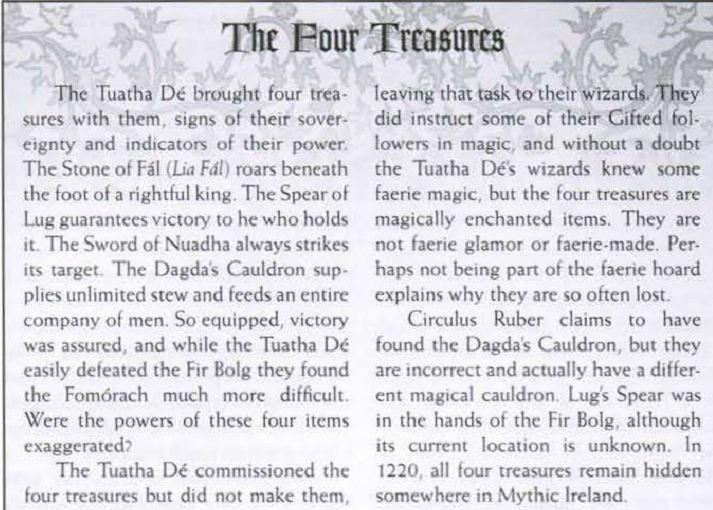
There were other heroes, to be sure, who never became high kings. The provincial king Ailill of Connacht and his wife Medb were fierce leaders, often at war with the king of Ulster, Conchobhair mac Neasa. Clan champions were as important as kings, too - most famously Cu Chulainn, Ulster's champion, and Fionn mac Cumhaill of Leinster. The lists of heroes and kings are immense, memorized by poets to recite grand genealogies. The Fir Bolg stayed in Connacht in this time, the Tuatha De Danann underground and the Fomorach offshore. All left the Milesians alone, keeping to their old pacts. Certainly, people met individual Fir Bolg and Tuatha De, but no more than that. The early Milesians kept guard against the Fomorach, but after generations without sighting their ships, the lookout was abandoned.
Next Time: The coming of Christians and wizards.
Ireland is Catholic
Original SA post Ars Magica: The Contested IsleThe first Christians to come to Ireland were not people you've probably heard of. Everyone knows Patrick, but he was not the first. The first was Palladius, who came with his assistants, Auxilius and Secondinus. He brought the teachings of Ambrose and Augustine, but when he landed in Clonard, the Irish did not welcome him. No one knows what happened to him in Ulster, but he did not succeed in his goal of conversion. Patrick came later, in the fifth century, though the date is unclear. He was a slave, captured by Irish pirates raiding the English, but his guardian angel, Victor, helped him escape. Still, Patrick heard a divine message telling him to convert the Irish, and as an adult he returned to preach. He made a circuit of the island, from Leinster to Connacht to Ulster to Meath to Munster. He performed miracles, casting out the snakes and defeating and exiling druids after a magic contest. He used a three-leaf clover to explain the Trinity, and he was overwhelmingly succesful, becoming the 'Apostle of Ireland' and cementing Christianity in the hearts of the people. He is now interred in Down Cathedral.
A few centuries later, in 778, two Tytalus and two Merinita magi came to the isle, seeking the legendary treasures of the Tuatha De Danann. With the help of a local ward-maker, they discovered the Dagda's cauldron buried in the mounds of the Bru na Boinne. However, the high king noticed their grave robbing and sent a druid and warband to confront them. The magi find a barrow they could defend, and the ward-maker protected it with his magic. They sent the first attack away, but the druid swore to them that the king's men would come again by morning. The lead Tytalus replied to him: We will defend this mound for a year if need be! They repelled the morning's attack, and two more attempts over the next three days. Keeping to their boast, they remained at the mound a full year.
After that, they decided to stay, and relocated to the western shore of Munster, again saying they'd defend their location for a year to prove themselves. They named the plce Circulus Ruber after the wards of their local assistant, and in two years it was a full covenant, the first of Ireland. Thirteen years later, Diedne came, hoping to recruit the druids of Ireland. They rejected her, and she spent the next seventeen years murdering every druid she could find. Cuin-dallan of Ulster, known to the Order as Quendalon, returned from Germany to save what he could of the older magical traditions. Aided by his House, he brought some into Merinita and hid others in Connacht. Meanwhile, House Diedne formed covenants in Ireland. By the early 9th century, there were still many native traditions, some hidden, some protected by kings or Hermetic allies and some strong enough to fend for themselves. Some of them joined Pralix in her war against Damhan-Allaidh, and the survivors eventually became the core of House Ex Miscellanea.
In the meantime, Norwegian and Danish Vikings began to raid Ireland in the late eighth century, focusing on the wealthy monasteries. They were named Ostmen by the Irish, meaning 'Eastmen', for they came from the east without warning. At first, they came only by spring and summer, but by the turn of the century they decided to stay for good. They seized and converted Irish coastal ports into permanent settlements. Every major Irish city, including Dublin, Waterford, Wexford, Cork and Limerick, was made by the Ostmen. They brought their rune wizards with them. The Order, having been in Ireland but 20 years, were not prepared for the Scandinavian aggression. At the Grand Tribunal of 832, the magi of Hibernia called the Ostmen wizards 'the Order of Odin,' and uncertain of their strength, they sought peace. Mael-tuili of Merinita met with the rune wizards of Dublin, promising tribute, but he was attacked and slain, along with most of his group.
Still, the Vikings were worse in other areas, and most of the Order stopped paying attention to Ireland. Many Hibernian magi had hoped the Ostmen threat would unite the Order in Ireland, especially the quarreling Ex Miscellanea and Diedne, who had never gotten along. (Diedne and Pralix, in fact, tried to kill each other at least once.) The tensions did not resolve at all - in fact, more tensions arose, between Hermetics and native wizards. Battles against the rune wizards, raids against druids and certamen duels were common. While individually weaker than magi, the Irish native wizards were members of the existing tuatha and could call on kings for aid. Border disputes and skirmishes over resources were a constant problem. To end this, the Irish magi agreed to acknowledge the Coill Tri, a confederation of hedge wizards that had earned the title of druid, and to make peace with them. House Diedne refused to join in this agreement, but on the verge of what seemed to be open war, they retreated from Hibernian politics. In 851, the Primus of Diedne, Obregon, announced that Diedne magi would no longer protect their "undeserving sodales", and the Diedne of Ireland retreated to their covenants. In their absence, the Trey of Cnoc Maol Reidh was signed. More on that later.
Still, House Diedne had a dominant position in Ireland. They refused to recognize the Treaty and entered Connacht regularly. As a result, hedge wizards made treaties with individual magi for protection. Adapting the concept of amici, with the moral duty to support and wage Wizard's War for each other, some magi became protectors of the natives, though always in a one-to-one relationship. These agreements stopped some Diedne raids, but were ineffective against raiders from England and Scotland. In 865, the Hibernian magi raised this point at the Grand Tribunal, but were told that their treaty was illegal, and that since Ireland was part of the new Britannian Tribunal with England and Scotland, they had to obey the Britannian Peripheral Code. Already upset, the Irish magi explained the importance of the Treaty of Cnoc Maol Reidh, saying that given the choice of joining or dying, the Irish hedge wizards preferred greatly to fight and die - a course that would destroy their traditions. The treaty would allow them to continue, perhaps to be explored and incorporated into Hermetic theory. Invading magi, they said, threatened the accord...but to no avail. The Grand Tribunal would not recognize it.
Thirty three years later, after the Tytalus showed that a Tribunal could secede, the Irish magi left the Britannian Tribunal, forming the new Hibernian Tribunal, which immediately ratified the Treaty of Cnoc Maol Reidh. Every individual treaty between hedge wizard and magus was made binding, and those who had ignored such treaties were brought to helel. With the external raiders stopped, Hibernia focused on internal conflict. The intrinsic rebelliousness and aggression of the Irish gave rise to several foundational cases of the Hibernian Peripheral Code. Local rulings on treaties, trophies and legal raiding were a safety valve for Irish violence - allowing contained conflict, it was thought, would prevent greater war.
The 10th century was a violent one, Irish and Ostmen fighting each other and themselves. The Hibernian magi, prohibited from getting involved in royal conflicts, followed their own interests. The Diedne magi were plentiful, but stayed behind closed doors, while the Coill Tri stayed in Connacht. The threat of war with the Ostmen wizards never happened, though skirmishes were frequent. The Irish clans kept the interior, the Ostmen kept the coast. As the Ostmen converted to Christianity, the two groups began to merge and cooperate, mixing OStmen mercantile efforts and Scandinavian mercenaries with Irish beef and leather. In the meantime, the Irish magi igored the growing skirmishes in Normandy and Provence. They were rather more concerned with the Munster kin Brian Boramha, known to the English as Brian Boru, who was making a bid for the high kingship. He lead thousands of men, aided by Munster druids and hedge wiards, and many believed that he could unite Ireland. Thus, the Schism War took the Hibernians by surprise.
The Tribunal contained six Diedne covenants. Some magi were reluctant to attack them, for they had not been a problem in ages, but others were swift to act. To their shock, three of the six covenants were empty when attacked, their members fled to other covenants, either on Ireland or elsewhere. Overeager, the Hibernian magi split their forces and attacked each of the three that remained at once. But the Diedne had made alliance with the supernatural powers of Ireland in anticipation of these assaults. Suil Braddin, the covenant Salmon's Eye, was a Diedne group in Munster that joined forces with Donn, Tuathe De god of death. Scornach Baintri, the Widow's Throat in Ulster, had enlisted a fleet of Fomoir warships. Five of these ships sailed up the River Shannon, while five attacked the coastal covenant of Circulus Ruber. The third Diedne covenant, Culraid Logha (Lugh's Retreat) was in the Hollow of Shannon, a remote spring in the Dartry Mountains that fed the River Shannon. The split force regrouped to relieve Circulus Ruber, defeating the Fomoir fleet there...but that left the other ships free to reach Culraid Logha.
With Circulus Ruber secured, the Hibernians attacked and destroyed Scornach Baintri. Twom onths later, they tried to do the same to Culraid Logha, but failed. Almost a yer after that, the Munster Diedne and Donn's forces destroy Cosan Crolaire (Warbler's Way), a covenant near Lough Leane. The Hibernians united to defeat the Munster Diedne, razing Suil Braddin and forcing Donn to return to his island. With their forces weakened, they still gathered one last time to attack Culraid Logha. As the day of the attack grew near, two years to the day since the first assault, the druids and hedge wizards of Connacht came to join the fight, informed of it by Mercere messengers. The combined force destroyed Culraid Logha, killing the Diedne and the Fomorach defending it. This battle is known to poets as the Third Battle of Moytirra. The Hibernians believed Ireland to be free of the Diedne, but they were wrong.
Brian Boramha continued to move across Ireland, having taken Ulster and Connacht. He went next for the Ostmen of Dublin, but as they marched east, Boramha's druid, the dwarf Muircheartach mac Lia, told the Flambeau magi of Lambaird that Boramha had druids with him who named themselves 'sons of Diedne.' The Lambaird magi realized that some Diedne magi must have survived, and they headed to the battle. The Irish and Ostmen clashed at Clontarf on Good Friday of 1014. As they battled, the Flambeau traveled the field, hunting the Diedne. Their battle was brief, flamboyant and deadly. By the end of it, no Diedne magi lived on Irish soil. The Irish defeated the Ostmen, ending their threat forever...but Boramha died in the battle. His army returned to Munster, to weak to conquer the island.
The war of Brian Boramha upset the balance of power. By destroying the Ui Neill control of the high kingship, he showed that whoever had most power could become high king - and that it was worth fighting for. Many tried, and the next two centuries saw high kings from all provinces. Not all ruled unopposed - some were known as the ri co frasabra, the high king with opposition, as some clans would not acknowledge them. No high king was able to keep the title long enough to pass it to an heir, and violent power grabs became routine, as did raiding, destruction and mutilation of rivals. The pattern went on without end, and many think the English are just continuing it now.
In the meantime, the Irish Church had its own problems. The laity were lax, tithes went unpaid, violence against clergy was commonplace and many sacraments were ignored. Priests married and passed benefices to their children. The archbishop of Amnragh, Mael Maedoc (remembered by Europe as Saint Malachy) went to great lengths to reform the Church. Due to his efforts, ratified in 1152 at the Synod of Kells, many of the worst excesses ended. Ireland was split into 36 sees, with four archbishoprics at ARmagh, Cashel, Dublin and Tuam. Despite this, the Irish Church remains notably different from that of Rome. More on that later.
Despite all the violence and tumult, the 12th century was a time of great art, too. Books were made in greater number than any past era, driven by the desire to record and remember the old ways. Several monasteries became expert with vellum, while others became famous schools for illuminators. Hermetic magi added to the demand, and it's a rare Irish grimoire that isn't highly decorated. Gold and silverwork was common, but all these fine arts are hidden by the half-deserved reputation of Ireland as a barbaric, violent and lawless domain.
The English were soon to change the Tribunal forever. In 1152, Diarmait Mac Murchada, King of Leinster, abducted Derbforgaill, the wife of the King of Briefne, Tighearnan Ua Ruairc. This was the catalyst for great tragedy, and to this day, Derbforgaill is remembered as the Irish Helen. She herself was quite happy with things, settling in with Diarmait, but Tighearnan invaded Leinster in 1166, and the men of Ossory rose to rebel against Diarmait. He lost his throne and fled to English exile. There, he sought aid from Henry II to recover his lands. The new High King, Ruaidri Ua Conchobair, had taken Leinster, and Diarmait was unable to persuade Henry to invade. Instead, he gathered mercenaries to do the task himself. When this failed, he turned to the Marcher Lord Strongbow of Wales, EArl of Pembroke. Strongbow agreed to help, invading Leinster and placing Diarmait back upon his throne. Diarmait's rage at his old foes was infamous, and after one battle against the men of Ossory, he had his English allies make a pile of two hundred severed heads, searching through them for one particular foe whom he hated especially. He chewed the lips and ears off that one. Strongbow married Diarmait's daughter Aoife, and on Diarmait's death, he took the throne of Leinster. This, according to many Irish, was agaisnt the Brehon Laws, but the power of his mercenaries was too much for anyone to act against.
The success of Strongbow worried Henry II, who headed for Ireland to bring the man to heel. Strongbow immediately surrendered, and once in Ireland, Henry demanded vassalage from the Irish kings as well, who gave him tribute. In 1185, seeing his barons carving out land in Ireland, he sent his John to be Lord of Ireland. Prince John set off to receive homage, accompanied by the Welsh priest Gerald of Wales. Gerald went on to pen two popular books on his experiences, the Topography of Ireland and the Conquest of Ireland, which showed the Irish as savage and exotic. Few in England and Wales knew anything of Ireland, and Gerald became popular for giving public readings of his book to massive crowds. Prince John was much less successful. He was only 17, and his tactlessness was already legendary. (It would lead to the English Baron's Revolt later.) When the Irish kings came to do him homage, he openly mocked them and tugged at their beards.
For many magi of the Stonehenge Tribunal, Gerald's texts were a wake-up call. Some had visited or met Irish magi, but the ORder in Ireland was insular and little-known to others. Many had heard of the marvels of Hibernia and heard stories of vis so plentiful that it was left unharvested, tales of a quarter of the isle left untouched by Hermetic magi, where druids still ruled. Hibernia was suddenly the talk of Stonehenge Tribunal, a place of mystery, wealth and danger. Some feared Connacht - what if the Coill Tri were the secret heirs of Llewellyn, last Primus of Diedne? What if the Order of Odin had a foothold in the Ostmen? Henry's conquest of Ireland was justified with a reference to the Papal Bull of Loudabuiliter, in 1155, which could be read as giving him the right to conquer Ireland and reform its Church. The reforms of the past century had made it moire like that of England and the continent, and in the same way, the Order of Hermes in Stonehenge were becoming disturbed by the customs of Hibernia and began to talk of a need to reform it. A few Stonehenge magi attended the next Hibernian Tribunal, and were shocked by what they saw.
Next Time: The English expand.
Ireland is English
Original SA post Ars Magica: The Contested IsleIn the meantime, Hugh de Lacy conqueres Meath, and the King of Briefne dies at a peace parley, possibly of assassination. The English move into Munster and Ulster, but Connacht, home of the High King Ruaidhri Ua Conchobhair, remains free. Ruaidri submitted to Henry, but his continued autonomy caused the magi of Stonehenge to fear the potential of the Coill Tri and what they might be doing and represent. After all, it made no sense to them that Connacht avoided all harm. With increased English presence, several English magi traveled through Ireland, and many felt their suspicions justified - especially in 1190, when a traveling group was attacked by what seemed to be a young Irish magus. The English magi, knowing nothing of the Irish custom of macgnimartha (more on that later), were very upset when Damisona of Jerbiton was attacked and three of her grogs killed. This led to a great outcry for something to be done about Hibernia.
The Grand Tribunal of 1195 was home to a huge debate about whether Hibernia needed reform to be more traditional, in the manner of Stonehenge, and whether a Tribunal should have the autonomy to set its own Peripheral Code. The parens of the paprentices who, in their macgnimartha, had attacked Damisona, were convicted only of a Low Crime, outraging the Stonehenge magi. This led to much more travel and visiting of Hibernia by other magi, as well as more appeals ot Magvillus from magi who felt the Irish Quaesitores had been unfair. The covenant of Elk's Run was founded in the aftermath. Meanwhile, in 1209, the maga Swan of Ghent was killed during the Black Monday massacre of Dublin, when Ua Broin raiders killed several English settlers.
In 1213, the magus Holzner of Tytalus, a German magus, joined the covenant Praesis. He then tried to steal its cathach and flee, but was slain by his sodales. (More on cathach later.) His outraged parens, Ballack, left the Rhine for Hibernia, laying siege to Praesis. Many Irish magi saw this as a clear case of foreign aggression, but by convention of the Tribunal, few interfered. The Siege of Praesis lasted a full year, preventing many of its members from attending the Tribunal of 1214, and straining relations between the Hibernian magi and outsiders. Praesis fell, and peace was restored, but it is still an uneasy peace.
The English lords are increasingly asserting their authority and adopting Irish ways, despite the wishes of the English crown. The Irish kings chafe under foreign rule, outside of Connacht. The Hibernian magi, likewise, face tensions from outside. However, peaceful visits, trading and tolerance still exist, and the Hibernian magi see themselves as loyal to the Order. Not ever foreign magus is hated, feared or suspected, and there may yet be peace if both sides can overcome their fears and misunderstandings.
So, what are the Irish like? The basic social framework of Ireland is the clan - an extended group of people claiming descent from one heroic forefather. The English have imposed their own style of French feudalism on top of the Irish society, but their attempt to force it is failing. They aren't replacing Irish culture - rather, they are adopting it, becoming more Irish than the Irish.
Ireland is shaped roughly like a bowl, with a ring of low coastal mountains surrounding plains and forests full of rivers and lakes. The climate is warmer and wetter than England, with only rare snowfall that never lasts long. Rain is plentiful, especially in the west, and some say it rains three days of every five. Flooding is a big problem, and heavy rains can threaten early plantings. The Irish divide the land into cantreds, administrative areas controlled by a clean leader. The English have grouped several cantreds together as liberties, inheritable feudal properties, and shires, cities and their nearby land which belongs to the king. The lord of a liberty has more independence than the lord of a shire, who is after all just the king's agent. A lord of a liberty keeps their land-rents and taxes, while the shire-lords give much of that to the king. On the other hand, more money passes through a city than rural area, so shire lords are often wealthier.
Prosperity, rank and honor are measured in cattle. Cattle raising and thieving are the cornerstone of IRish society. LArge herds need large pastures and must move often. Grass grows year round, of course, but relocation prevents overgrazing. Summer pastures are higher, farther from home, while winter pastures are closer. Because of the many wolves of Ireland, farmers build roofed, fenced areas known as byres to keep cows safe at night. Sometimes, a small byre is attached to a house, but usually it's a standalone. Nobles and honorable farmers are expected to keep a number of cows appropriate to their station. If the herd gets smaller, their standing falls, which makes cattle raiders dangerous to both herd and honor. Cattle are branded to identify their honor, but even so, retrieving stolen cows from a powerful foe is hard. A man's responsible for his herd and any losses from it. Success in reclaiming stolen cattle depends on power and allies.
Besides cattle, farming provides some of what a farmer makes. Primarily, that's oats, then wheat and rye. Because clans move often, fields are temporary and usually unfenced. A plot will usually only give two harvests before it's abandoned or ruined by cattle and spring rain. Cows graze freely, and legally have the right to walk through a field of crops if water is on the other side. A land-owner who blocks cows from water is a criminal. Most of the Irish interior is forested, with apple, hazel and oak trees providing food and fuel. The forests are full of animals - boar, fox, badger, wolf, deer, hare and squirrel. Cattle can also be found in the woods, but they're poor grazing, and wild cattle are rare. Outlaws and fgiannai live in the woods. A fian, you see, is a band of young aristocrats who go into exile while awaiting land inheritance. They are seen positively as future warriors who must prove themselves to their clan by surviving outside it . Outlaws are legal outcasts, denied aid by all. With the recent English invasion, many outlaws' only crime was owning land the English wanted. Such men are heroes to their neighbors, and the outlaws will be trouble in the coming years.
IRish society is centered on the clan, whose basic social unit is the tuath, which means 'people' but includes the clan's native territory, its free clients, unfree clients and slaves. Tuatha are named for a hero-ancestor, and most originated in the fourth or fifth centuries. New tuatha appear when a powerful leader seperates from the previous one to form a new clan, while weak tuatha disappear when destroyed or absorbed by a greater tuath. As of 1220, there are about 125 tuatha. The most powerful are the "five bloods": the Ua Neill of Ulster, the Mael Sechnaill of Meath, the Ua Conchobair of Connacht, the Mac Murchadha of Leinster and the Ua Briain of Munster.
The Irish divide themselves between the daorcheile, those without honor, and the grad flatha, those with it. The daorcheile are peasants, whether they're slaves, unfree farmers or free farmers who barely own enough to survive. The grad flatha are wealthy free farmers, nobles, priests, monks, professional judges, doctors and poets. Most social standing is hereditary, but personal honor does play a significant role. Every free man has an honor-price, an eraic, which is the amount payable in compensation if they are socially or physically injured. This is paid in cows, and it can grow and shrink depending on your fortunes. Besides physical harm, damage to reputation, social connections and property demand payment, with prices set by the type of injury. A verbal slight might merit a significant chunk of a man's eraic, while murder would pay the full amount.
Most people are daorcheile. Slaves are taken in raids, though that's rare these days. Unfree farmers, or bothach, get a cow and a small plot of land in exchange for their labor, with interest so high it can never be repaid. A free farmer or boaire is also a client, but has a better interest rate, one that can eventually be paid off. The terms a lord offers, determining whether a farmer is free or not, are hereditary. The grad flatha have many ranks - lesser nobles who have the minimum number of client boaire, cattle lords and greater nobles. The most important nobles of a clan are the derbfine, those within four generations of the current chief. Each clan has a chief or king, the ri. The king of a single tuath is a ri tuaithe. One who holds several other tuatha as clients is a fuirig, or over-king. A king of over-kings is a ri ruirech, and a king of one of the five provinces is a ri caicid, a provincial king. The grad flatha also includes the professional learned classes - judges, poets and doctors. Many of those jobs are hereditary, with only a few families doing the job for a tuath. All posts require intensive training, roughly equivalent to the academic career of continental university teachers. The kings of the more powerful tuatha appoint an ollamh of each position, the titular head of that class within the tuath.
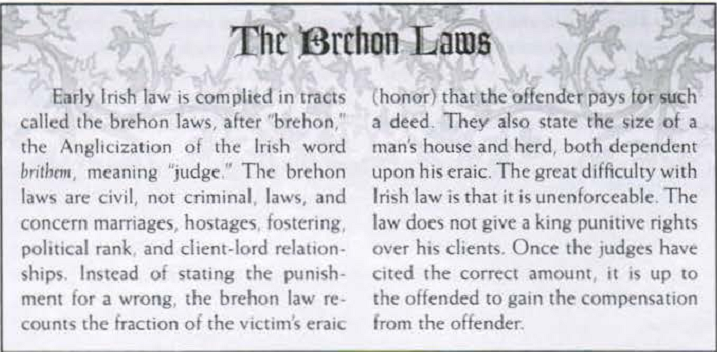
Every tuath holds public assembles, oireacht, which meet at a specific location at set times each year to determine clan business. Assemblies often settle disputes, levy fines, collect taxes and, if needed, select new kings. The candidate must be of the derbfine of the last king, making everyone with a common great grandfather eligible. Sometimes, the derbfine chooses a successor before a king dies. Such a person is known as a tanaise rig, but having such an heir doesn't always stop dynastic struggles for power. A king is crowned in a sacred ceremony in which he symbolically marries the tribal lands. In some tuatha, this means literally marrying a local faerie woman, a sort of Tuatha De land goddess. The ceremony is highly ritualized and involves the king swearing to abide by the laws and gods of his people, to do no harm and to universally share the king's truth of legal and moral judgement.
Only 5% of IRish marriages happen in church - most are secular, solely requiring a couple to declare their intention to marry. Once that's done, the marriage is legal. The Church disagrees, but most Irish prests participate in it rather than preventing the practice, ignoring the 12th century reforms. Easy marriage means easy divorce and easy remarriage. The nobles are the worst offenders, marrying and divorcing as they please. Some men even have many wives at once, but that custom is fading. This loose view towards marriage allows a clan to grow very quickly - one Ua Donnell chief has 18 sons by 10 wives and 30 grandsons. There are other differences in Irish marriage that annoy the Church, Irish can marry first cousins, while canon law dictates three degrees of separation between partners. All of a man's legitimate sons can inherit, without care for birth order or even whether a wife is divorced, so long as the mother is not a slave. A wife does not bring dowry, but instead the groom pays her family a bride-gift. Lastly, an Irish marriage does not grant an alliance btween groups - or even stop aggression between in-laws. Marriage doesn't sotp or hinder conflict between a man and his brother-in-law, and the Irish men don't expect their wives' kin to follow them into battle.
Hostages are a common practice - noble sons given to a king to ensure a tuath's good behavior. The hostages live as part of the king's retinue. If the agreement between tuath and king is broken, their lives are forfeit. Since the hostages can be related to the king, and often are, the king may have sentimental reasons for not killing them, even so. Fosterage is common among the nobility, too - at age 7, noble sons and daughters leave home and live with foster parents. Boys stay until 17, while girls only until 14. Fostered children form emotional ties as strong as those with their parents. In all legal matters except inheritance, a foster son is as legitimate as a biological son, and a man can expect his foster sons to follow him into battle. Cuddy, the anglicized from of the Irish curd Oidhche ('a night's portion'), is the entertainment and feast a client owes his lord. One of the king's privileges is the right to travel through the tuath and feast at the nobles' houses. Most clients cannot refuse this, and several clients have bemoaned a gluttonous king. Poor nobles must borrow from their neighbors to provide the king's cuddy.
Ireland is full of villages, or rath - ringfots with wooden walls surrounding some huts. The larger and more powerful a clan is, the bigger the rath. Unlike a continental village, a rath is mobile, as the clan can quickly uproot and shift to a new location. Raths are not built on rivers or roads, but tucked away in secure areas. Small coastal ports do exist, but most of the Irish live in the interior. Christianity did change the raths some - instead of surrounding a chief's hut and his clients, the walls can surround a monastery, the monks and their lay supporters, the tradesmen and herders who supply the community. Monastic raths are self-sufficient and so found in the interior, with no need for coastal or river trade. Walls made of piled stone surround a stone church and tower, as well as several wooden huts used by the community's supporters.
The Ostmen brought cities to IReland. Originally, these longphorts were enclosed winter camps, but they became homes. Once the raiding ended, which coincided with the Irish adopting and learning to use Ostman weapons, the two groups lived in uneasy peace. The five cities of the Ostmen, Dublin, Waterford, Wexford, Cork and Limerick, remain home to them. Ireland has over a thousand raths, and the more powerful ones have stone walls. Religious centers, such as Armagh, Cashel, Kildare, Tuam and Dublin, as well as royal residences, use stone. They have given up mobility for a stronger, more permanent defense.
Next Time: More about the Irish.
Ireland is History
Original SA post Ars Magica: The Contested IsleThe Irish year is divided into two seasons, not four. (Socially. Ruleswise, still four.) Winter begins on Samhain, November 1. Summer starts on Bealtaine, May 1. Samhain is the end of the harvest season and the start of the dark half of the year. On Oiche Shamhna, the Night of November - that is, October 31 - the ghosts and faeries stalk the night, and the Tuatha De Danann move to their winter palaces, disrupting others. Bealtaine is the start of the planting season and the light half of the year, full of celebrations and cheer. Equally important are the celebrations of Lughnasa on August 1 and Oimelg on February 1, more commonly known as the Feast of Saint Brighid. Lughnasa is the harvest festival, celebrated on the closest Sunday to August 1.
While these pagan elements are retained and valued by the Irish, they are thoroughly Christian, not pagan. Christmas and Easter are the most vital holidays of the year - to the point that the rising sun on Easter seems to dance, increasing the piety of all that view it for the rest of the week. On Christmas eve, candles are lit to guide travelers, and at midnight on Christmas, all the animals of Ireland gain the power of speech until the sun rises. Hearing an animal speak is very unlucky, it is said, so most people stay inside.
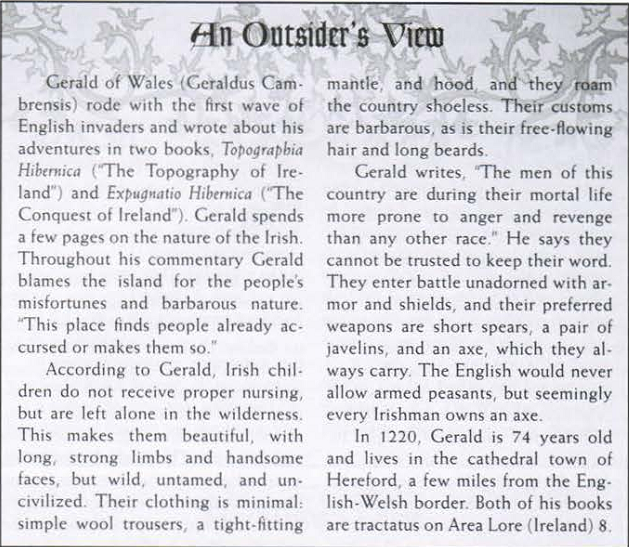
Poets and musicians are extremely prestigious jobs in Ireland. They are beloved by both the Irish natives and the English conquerors, moving easily between the two groups. Currently, love songs are greatly in fashion. A good poet, meanwhile, must memorized hundreds of tales to earn their title, and so they always know an appropriate story for any occasion. Hurling is a popular sport among the Irish youth of all classes - it is a game in which a wooden stick, the hurley or caman, is used to drive a brass ball. One team tries to move it towards a goal while the other defends the goal. Hurling is also popular in Scotland. It is a dangerous game, with frequent injuries and even some deaths. The faeries love the sport, and a good hurling player may well be abducted and forced to play hurling with them all night long. Rules are provided for hurling: specifically, it's an Athletics roll, and if a match becomes violent, a hurley has the same stats as a club. The Irish also enjoy horse racing - riderless, as in Scandinavia - and a type of chess known as fidhcheall, as well as backgammon (known as tdiplis) which is more popular among the English lords.
Performance magic is not rare in Ireland, both among magi and hedge wizards. Poets and musicians can go anywhere, and so they can be excellent spies - plus, most listeners will have no defense against sorcerous music. Hedge wizards who practice performance magic tend to use it to earn money and advance their clan politically. OFten, this leads to conflict with the English and bloodshed. A magus must be more careful - the native poets don't like having their role usurped, and the Order cracks down on too much mundane interference.
So, what of the English? Their ideas of power and political might are different than those of the Irish natives. English value land, Irish value cattle. Before the coming of the English, Irish would steal cattle but not land. Tuatha moved under pressure, but land grabs were never the goal. The English, however, want land, and their stone towers make it clear they won't be leaving any time soon. Irish sons inherit equally, via complex arrangements. They work the land and herds together for five years until a separation can be made, with shares distributed by the youngest son. The English practice primogeniture, with the eldest son taking all. An Englishman with an Irish wife often assumes he'll inherit her father's title and property, but her kinfolk will disagree. Royal succession is also different - the English kings follow primogeniture, as with other property. The Irish have no such guarantee - everything rests on the derbfine decision. Plus, in Ireland, a higher king has no authority over a lower king's rule - a fuirig cannot reverse the decisions of their client ri tuaithe, while an English king can easily reverse every lord under them.
The Irish have four languages in use today - English, French, Gaelic and West Norse. Gaelic is the native tongue, shared with Man, the Kingdom of the Isles and Scotland. Each province save Meath speaks its own dialect. The Finn-Gaill of Dublin (that is, the 'white foreigners') have adopted Leinster Gaelic, but the Dubh-Gaill ('black foreigners') of Wexford, Limerick, Waterford and Cork speak West Norse still. The lords of the Norman occupation speak French, while their servants prefer English. The educated, of course, speak Latin.
So, let's talk about the Hermetic culture. Hibernia's contradictory. It is old, but newly rediscovered. It is conservative, yet very strange to outsiders. It allows easy conflict between magi but protects hedge wizards. The most obvious divide is between the Irish native magi and the new arrivals, of course. Hibernia has grown away from the rest of the Order for years, developing its own culture. Newcomers see these ways as outdated, nonsensical and often undignified. Were there more land, the two sides might get along better, but Ireland is not a big place.
The generations-old Irish covenant Praesis has fallen, besieged in a year-long Wizard's War and finally felled by betrayal. Behind this battle was the conflict of Hibernia's Tribunal: land must be protected and challenged. Covenants are not the sum of their members, but the result of ancient and powerful artifacts chosen as symbols. The standing of magi is not based on learning, but their ability to protect their own. Any magus unable to protect their land is unworthy of it. That is fundamental to the Order in Ireland, and is the means by which outsider magi have gained a foothold, earning their share of riches. The siege of Praesis was mostly between the ORdo Hiberniae, as the Irish magi name themselves, and the continentals, as they name the English. However, not all of Praesis' attackers were foreign. Some were Irish, using the conflict to rail against centuries of restrictive traditions - an increasingly common attitude among young magi. And while it fell, the siege of Praesis continues to be a pivotal point in Hibernian politics. If, as they did at Praesis, the Ordo Hiberniae lose control of the Tribunal, centuries of tradition may be overturned in a single generation. There are two factions, then, vying for control of the Tribunal - both politically, and among wilder magi, more directly.
Ireland is a land where history is known to go in cycles. This isn't mere lore - it's truth. The Treaty of Cnoc Maol Reidh is centuries old, an agreement between the Order and the native hedge wizards that irrevocably grants Connacht to the hedge wizards as their own land. When the Order took hold of Ireland, the druids were pushed aside, granted the land to seal the peace. This was just as the Fomorach were driven to the north, the Fir Bolg to the west and the Tuatha De Danann underground. Some believe the Ordo Hiberniae, likewise, will be forced to retreat to Connacht, leaving the island to the continental magi - it can already be seen in the English conquest.
Most older Irish magi view the English with suspicion and concern, but the younger magi, especially those in their macgnimartha, have heard the English message and embraced the idea that no part of Ireland should be denied them, that the treaties are outdated and should be annulled. Most of the English magi find the Irish to be backwards and strange. Most know the old tales of Ireland as too dominated by faerie power to be much use, but nothing recent until around 1170. House Tremere were the first take note - the archaic, dangerous and strange traditions were at odds with good Hermetic governance, they felt, and that could not be allowed. While they are called 'English' for the first Stonehenge magi to come, the continental magi come from all over, initially supported by House Tremere, to claim new territory over the last fifty years.
Why so keen to reform now when previous efforts have failed? Firstly, while the protections of hedge wizards are legal, they seem to set the natives on par with magi, which is improper to many. Secondly, the continental magi are now settling in Hibernia, clinging still to their own views on the Code. In their own way, they're as conservative and change-resistant as the natives. The English prefer the normal practices: harvest vis, intimidate hedge wizards and ignore those that aren't useful. Connacht, to them, is land ripe for taking. However, they've been here fifty years now. Some have raised apprentices in Ireland. While these apprentices were denied macgnimartha and still see themselves as different from the natives, by the next generation, the distinctions may fade.
Violence is common in Hibernia. Wizard's War is easily declared, certamen frequent and grog raids similarly common. Most covenants own resources that lie outside their legally protected territory; such resources are always at risk, though the Hibernian magi do take the Code seriously. Battle is to assert dominance, not kill, which is why certamen is so common. Grogs, well...grogs die a lot. There is, however, an understanding that things will find their own level. The threat of violence is real, but often the best ward against it is to be a good neighbor. The Peripheral Code doesn't mandate this, but those who break the unspoken rules often regret it.
So, what exactly is a macgnimartha? It means 'youthful exploits' and it refers to a brief period between apprenticeship and becoming a magus. In this period, the apprentice leaves their parens and covenant and spends a year or more unprotected and unsupported. They have sworn no Oath, have no Parma Magica and are outside Hermetic law. Most test their power against faeries, some against mundanes and others against Hermetic targets. In the last case, stolen magic items are usually ransomed back. Magi of Hibernia all remember their own macgnimarthas, and rarely treat those in one harshly. Importantly, the Treaty of Cnoc Maol Reidh makes no mention of macgnimartha, and the youth often head to Connacht for their sport or fortune. For most apprentices, the macgnimartha lasts a year, or "until his beard encircles his chin," at which point they swear the Oath and are taught the final secret of the Parma. Their character and reputation are judged by their deeds in macgnimartha. Despite social pressure, since failing to take a macgnimartha can reflect badly on the parens, not all apprentices undertake it. Some instead go to Leth Moga, where they are given security, lodging and use of the library in return for assisting others and copying books.
What makes Wizard's War different in Hibernia? Well, the declaration. The formal declaration must be given in person before witnesses, but not necessarily directly to the target. It must be public, of course, and Wizard's Wars have been declared invalid if the magi involved took steps to keep the target from finding out. But there is no warning letter, and while the formal declaration must still be made one month in advance, it's common for the target to find out some ways into that month and have less time to prepare. A magus may also declare Wizard's War against multiple foes by naming them in the formal declaration, which can draw allies in on both sides. You can declare war on 'all who hold to the Gae Bolg,' for example. Hibernia's Code does not require months of break in a war, so many magi extend the war as soon as it begins - indeed, the Peripheral Code assumes that Wizard's War is extended unless there is positive evidence that it wasn't, so a War typically lasts until the death of one side, a surrender or a treaty. In practice, they tend to devolve into raiding and theft until one side calls a truce. Grogs and mercenaries are often used as proxies, so it's typically more about submission than murder. Famously, a state of war continues to exist between the magi Grainne inghean Uaitear of Vigil and Cu Chonnacht Cluasach Mac Tire, despite the fact that they've met several times while the War has been on. The Siege of Praesis, however, was the first extended Wizard's War most English magi had seen. Given the results ('Praesis fell to them'), opinions are mixed on whether the law should be formally challenged.
Certamen, now. The polite rules of Certamen that are so common on the continent do not apply here. The aggressor picks the Technique, the defender the Form, but neither has right to veto and there are no social norms about who can challenge when or how often. Certamen is often fought over resources outside protected lands, or between magi before things escalate to Wizard's War. The usual social stigma about refusal to fight is especially strong in Ireland, but there is no stigma against using vis in certamen matches.

Next Time: Responsibility of the Order
Ireland is Hermetic
Original SA post Ars Magica: The Contested Isle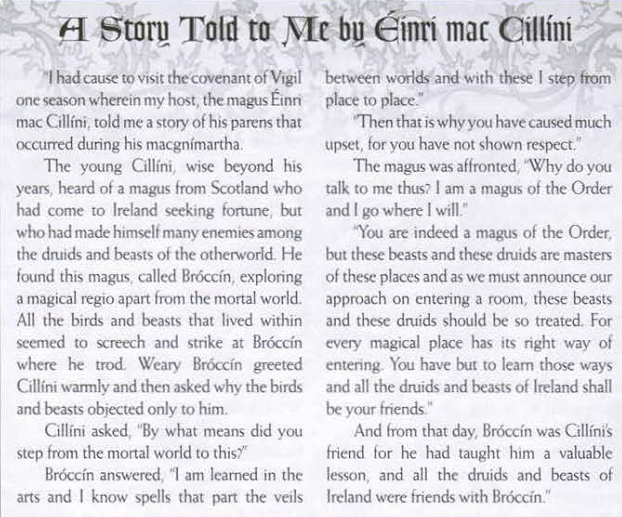
The Order of Hermes assumes the ultimate supernatural authority in Ireland, claiming the right to act against those who break convention and flout their power to cause chaos. Even the elder races listen when the magi speak. The Order does have a history of respecting the Treaty of Cnoc Maol Reidh, allowing the Coill Tri to manage their own lands, but they are ready to punish magical beasts that terrorize villages or faeries that prey on travelers...and unless a hedge wizard's own tradition acts first, the Order is willing to punish them, too.
Hibernian philosophy holds that a coven of witches is not really that much less than a covenant of Bonisagus. It is by deeds that worth is measured, they say. The Order in Ireland feels a responsibility to maintain the old ways. This is not a cover for pagan sympathies at all - rather, it refers to the non-Latin forms of magic found in Ireland before the Order came, dating sometimes back to Nemed and Partholon. These were precursors to the Houses of Hermes - shapeshifting druids, faerie dealers and enchanters. If the Order forced them to join, those ways would be lost, or at least diluted. The Hibernians claim any threat they might post has been neutered by confining most hedge wizards to Connacht.
Magic and Faerie auras are precious in Ireland, for they are often tied to important historic events. Magi there feel a responsibility to these places and to caring for them. This can force them into conflict with mundanes, and in those cases, the Tribunal favors a strong show of authority. Protecting an aura from mundanes is not considered interference. Outside Hibernia, vis is often harvested as soon as it appears, then hoarded. In Hibernia, this practice is considered to be at odds with good husbandry of magic, and vis is typically left unharvested untul it is needed. Magi typically store only small amounts of vis, mostly gained by trade or luck, and visit their vis sources frequently to gather waht is needed at the moment. Many sources are turned into casting spaces for rituals, and Irish magi often use vis that has not been moved out of its original form. Since most sources have vis available all year, though, they make attractive targets for raids or hungry beasts. Traditionalists of Ireland see this as just a risk to be managed, much as mundane farmers must guard their crops. Extracting vis from auras is seen as detrimental and against the principles of responsibility. Fortunately, Hibernia has many vis sources, so few magi feel the need to break tradition there, or to steal vis from others.
In Hibernia, magical beings able to talk are considered equal to humans and are given a voice at the Tribunal. This status means no covenant may molest these creatures or take anything from their territory without permission or at least tribute in kind. However, even the Irish are a bit lax in this regard, and the strength of nearby magi and covenants tends to impose itself on the power dynamics of the magical and faerie beings nearby.
Hermetic literature in Ireland is still predominantly in Latin, but thanks to the influence of the Irish Church, the use of vernacular Irish is increasing and can be found in the marginalia of many Hermetic texts. The Ordo Hiberniae are very fond of chronicling the lives of important magi and historic figures, and they often produce texts detailing them. Continental magi tend to view these as a distraction from study of the Arts or creating spells. In fact, they tend to find Irish books on Hermetic theory dull and overcomplicated, much as their mundane counterparts view Irish histories, as they tend to dwell on minutiae over practical application.

The continental magi tend to be annoyed by many things the Irish take for granted. They find Irish vellum to be greasy and unsuitable, and some even import parchment. They complain of oversalty food and even bring in foreign cooks. The Irish often practice beekeeping, and the trading of honey is a tradition among Irish magi, as each covenant has a unique flavor. Continental magi find this twee and undignified, but many Irish take great pride in it. The Irish magi tend to refer to House Ex Miscellanea as 'the Younger House,' and while this is accepted by Irish Ex Miscellanea, continental Ex Miscellanea find it insulting and grating. Finally, it's usually easy to tell the two factions apart by their outfits. Ordo Hiberniae often wear mantles of patchwork colors or pattern to denote status; apprentices wear plain, single-color cloaks and those in macgnimartha wear three colors, magi wear five and the Tribunal praeco wears seven, and the heads of covenants can wear six. This has not yet caught on among continental magi, who generally follow foreign fashions.
And now, let's talk treaties. Treaties record agreements between covenants or any other supernatural group. Most Hibernian law is made of specific treaties for specific people and cases rather than general precedent. This makes it dense, counterintuitive and cumbersome - rulings don't provide precendents all the time, even when the same elements are involved, and the English magi find this untenable. They want change. In many ways, the treaty system mirrors the Brehon Laws.
A treaty can be made between any individuals who have the right to be heard at Tribunal. This includes magi, covenants, the Order of Hermes itself, the Tuatha De Danann, the Coill Tri and so on. A treaty can be temporary or permanent, or have conditions within it that release the parties involved from it. It's the job of the parties on either side of a case to come to an agreement, with Quaesitorial aid, and the Tribunal's role is to ensure that neither side breaks it. No treaty can break the Peripheral Code or bind a magus to actions that would break the Oath of Hermes.
Now, covenants. The Order requires any magus to be resident of the Tribunal to be able to vote. In Hibernia, this means belonging to a recognized covenant. Those outside a covenant are considered vagrant and risk exile, no matter how long they've lived on Irish soil. However, any magus can found a covenant, so long as they have land, wealth and a trophy - a cathach. The land must be any space upon which to build a home that the magus has protected for one full year. For historical reasons, wealth means cattle, so covenants must have cattle. The cathach, meanwhile, is an item or relic of some significance to the covenant, which must be displayed at Tribunal to identify the covenant.
A cathach must meet certain conditions. First, it must be a magical treasure - not necessarily a Hermetic treasure or even of the Magic ream, but it must trigger a positive response to magical identification. Second, a cathach must be taken, not made by the claimant magi. It might be taken from the land, from the magic realm or from another magus or covenant. The nature of its acquisition is important, for it becomes part of the story of the cathach and the character of the covenant. Third, the cathach must be significant. It must have a story behind it - either it is of legend or it was made by a legendary or noted figure. Last, it must be displayed. It must be brought to Tribunal to prove residency and, when not at Tribunal, must be kept outside the Aegis of the Hearth.
If a magus can hold those three symbols - land, wealth and cathach - and support themselves for one year, they have the right to represent themself at Tribunal. Other magi may attempt to seize the cathach before the year is out, and if succesful, the covenant may not legally form. The raiders must abide by the Code and may not harm resident magi outside a Wizard's War. However, any magus caught in possession of a cathach claimed by another forfeits immunity, as if they had entered a sanctum. Cattle are similarly protected, though they may be kept within the Aegis. This calls back to the earliest days of the Order in Ireland, when the four magi of Circulus Ruber made their vow to defend their land for a year if need be, along with its treasures.
Once a covenant has defended its cathach, land and cattle for ayear, it may petition the praeco for recognition and to have its name and lands recorded at the Mercer House of Leth Moga. From then on, they receive Redcap visits. A covenant's lands are defined by its vis sources, consisting of all sources that a magus may encircle between sunrise and sunset, without any spells or enchanted items to speed progress. These sources are protected by law, and any magus raiding them is committing the crime of depriving another of magical power. Sources claimed outside this legal boundary have no such protection, and for this reason covenants mark their sources with their symbol. No magus outside a covenant can claim Hibernian residency, and only those who prove residence can vote. Covenants that attend Tribunal without a cathach have failed to prove residency for their magi.
It can be tempting, and has been known, for younger magi to live outside a covenant. They have no cathach to protect, after all, and votes matter only once every seven years. Such a group, though, has no voice, no official Redcap visits and no legally defended property. Hibernia does not recognize chapter houses or vassal covenants. If a magus no longer wants to live in their covenant, they must enter or found another, or else forgo legal protection. Despite the obvious vulnerabilities, there are still many independent magi, with representatives from almost all Houses. In order to vote, they must produce a cathach, though, and must show that they havel and cattle. In all respects, they must found a covenant of one.
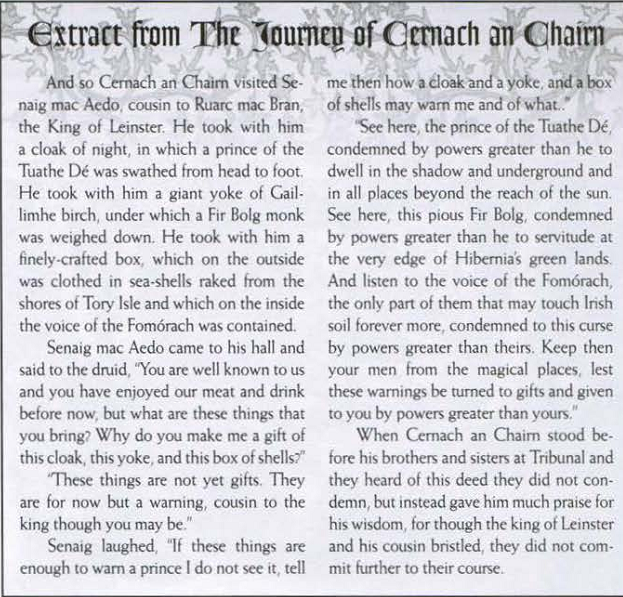
Next Time: Views on the Code.
Ireland is Tribunal
Original SA post Ars Magica: The Contested IsleSo, how do the Hibernians view the core of the Code of Hermes? Well, let's look at the clauses. The Deprivation of Magical Power clause is interpreted to apply only to those resources within claimed land protected by a covenant. Any resources outside that boundary are free game. You can put your marker on them, but you'll have to defend them yourself, not with law. The Slaying of Magi and Wizard's War clauses are taken as normal - any murder outside Wizard's War is a high crime. Forfeit immunity happens when you try to kidnap an apprentice, steal a cathach, enter a sanctum, assault a familiar or raid legally protected vis. We've already talked about how Wizard's War must be declared in Ireland.
The clause on abiding by Tribunal decisions is standard, though they have their own interpretation of what 'reasonable interpretation of the Code' means for purposes of overriding a Presiding Quaesitor's veto. The voting rights clause - well, any magus who can prove residence with a cathach has a vote, which they can give as proxy to others as normal. Hibernia also recognizes the votes of appointed supernatural ambassadors from the supernatural realms and ancient races. These votes have exactly as much weight as anyone else's. The Mundane Interference clause is taken with a Transitionalist view, since in such a small Tribunal with such a small population, where many magi will have familial ties...well, association with mundanes is inevitable. Ireland's kings have a history of going to druids for aid, and magi have been counted among them sometimes. Charges of interference require that the Order must be shown to have been endangered as a result.
Scrying, now, the scrying clause is also one that requires a lot of evidence. Without clear evidence of scrying detected by a "trustworthy person," the Tribunal requires that any information learned must have been impossible to gain by mundane means. Thus, most magi accept that some scrying is inevitable and prefer to settle things more directly than via complaints at Tribunal. The apprentice clause is taken not to apply to those in their macgnimartha - they are no longer their parens' responsibility. Bonisagus retains its traditional privilege, but any Bonisagus claiming an apprentice must do so either when they are first presented by the Coill Tri or their parens or at a subsequent Tribunal before the macgnimartha - so no stealing apprentices between Tribunals.
While the Casting Out clause exists, Hibernia prefers exile to casting a magus out of House or Order. An exiled magus must leave Hibernia under threat of Wizard's March. Exiles may petition to return, but must find a resident magus to stand for them and plead their case, which is then given to vote. The Enemies and Allies clause is taken to define all elder races of Ireland as allies - the Fomorach, the Tuathe De Danann and the Fir Bolg. The Coill Tri is also defined as allies of the Order by the Treaty of Cnoc Maol Reidh. This provides protection - an ally of the Order must be given the same warning as a magus of any Wizard's War.
Beyond that, hedge wizards in Ireland are generally considered allies of the Order. The protections this offers are not absolute, however. They may legally own a single vis source, and while they may use others, these others are not protected. House Mercere must take messages to the Coill Tri as they would any covenant, but individual hedge wizards only sometimes receive visits, and that's not official or required. A hedge wizard has the right to join a covenant, which in principle gives greater protection, but in practice they are expected to join House Ex Miscellanea and the Order. Wizard's War must be declared on hedge wizards before attacking them, as with magi, and slaying a hedge wizard outside a War is the crime of assaulting allies of the Order. Magi who declare Wizard's War on 'all hedge wizards' - which is legal in Ireland - are traditionally persuaded to allow their Wars to lapse. So far, no English magus has made such a declaration.
Any magus caught in possession of a cathach is treated as if they have invaded a sanctum. A thief must protect a cathach for a full year from all aggression if they plan to claim a covenant's resources. It'd be possible to disenfranchise a covenant by stealing its cathach and denying its magi votes at Tribunal, but doing so would risk making the Tribunal inquorate. Of course, few magi want to see the Siege of Praesis repeated across Ireland. Still, it's a foolish covenant that leaves a cathach undefended. Sure, they can't be in the Aegis, but many covenants make pacts with faeries or beasts to defend the cathach. It is tradition in Hibernia to live and let live, for the most part - the best protection against aggression is to not be so aggressive yourself.
Much as mundane Irish justice does not often kill, Hibernia rarely uses the Wizard's March or the destruction of either familiar or talisman as punishments. Compensation for damages and correction of errancy is the focus, and fines, obligations and restrictions are common, with exile as the highest punishment. Fines of vis outright are rare, however, and instead access to vis sources tends to be granted to the wounded party for a set period. Only one crime in all of Ireland is punished by March: trafficking with demons. Still, on the rare times that the clause of the Oath that requires execution is invoked, it is taken deadly seriously - though Hibernian justice does not pursue off the island, as a rule. Those who flee justice are considered exiled and, unless they return by the next Tribunal, will be cast out of the Order. In practice, however, no one tells anyone outside Ireland when this happens...but Irish memories are long, so if you flee, don't come back. There are few hoplites in Ireland, as it is expected that all covenants can defend themselves and will offer that strength when needed by the Tribunal.
The Irish work hard to maintain good relations with the magical and mundane beings of Ireland, and any magical beast that threatens that peace is punished by the Order. There is no set punishment, but faeries have been clapped in irons and magical beasts have been forced out of their homes or pressed into service. Enforced binding into servitude is the ultimate punishment, invoked only once in the past - there are lab texts for magic bridles, yokes and rings to command obedience, but no one is keen to see that incident repeated, though the threat is there.
When the Coill Tri break their agreements or obligations, they must make good to the Tribunal. The Order retains authority over Connacht, even if it does not enter it. As there is no Code for the Coill Tri, each case is judged on its merits. Those who displease the Order are forced to serve or give tribute in vis each season for a year, are banned from certain regions or given other punishments fitted to the crime.
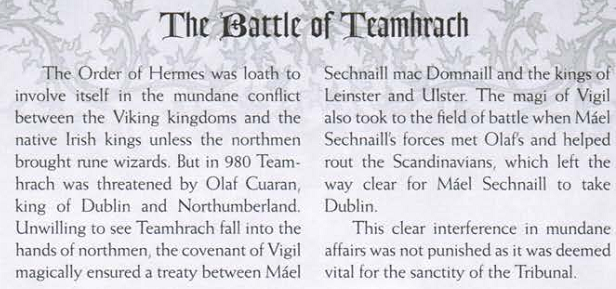
The Hibernian Tribunal meets at Cnoc na Teamhrach, the Hill of Tara, in Meath, which is home to the Lia Fail. Traditionally, Circulus Ruber makes all arrangements, including the spells needed to raise a temporary settlement. Before the Tribunal proper, embassies from the hedge wizards, faerie factions and magical creatures meet with magi to discuss things, in what is known as the Sacred Council. The Praeco and Presiding Quaesitor both attend, and other magi attend by invitation. All supernatural beings of Ireland may attend, and it is here that their ambassadors for the Tribunal are chosen. The Tribunal is always opened with a prayer from the Holy Tradition of the Celi De; currently, the role is filled by the magus Indrectach. The Tribunal typically lasts seven days and nights and closes with another prayer. Official business is in Latin, but Irish is commonly spoken casually. Weather is kept good by magic and food is provided.
While every recognized supernatural group may send an ambassador, the Infernal has never tested this right so far as anyone is aware. The Coill Tri choose their own ambassador from among their number, to speak for all hedge wizards in Ireland - including those who are unaware of it. This ambassador is responsible for ensuring the duties of the Coill Tri are met, and to handle issues dealing with hedge wizards. The role is not easy, and generally no one trusts the Coill Tri ambassador, including the Coill Tri. The English magi hold their own pre-Tribunal council to reach consensus on key issues, usually about Code reform, though the aggression of the covenant na Lam Baird is also a concern these days. Consensus isn't easy to get, and the council needs strong leaders. They do not choose an ambassador, as they are magi and can all attend and vote.
The Tuatha De Danann choose their ambassador at the Sacred Council, while the Fomorach and Fir Bolg always send ambassadors from their royal lines. Faeries outside the Tuatha De can send an ambassador, and if they don't, House Merinita will select a representative for them at the Sacred Council. Magical beasts that can speak human language may also select an ambassador from their ranks. If they don't, a magus of the Order speaks for them. Individuals other than the ambassadors may not enter formal treaties except via the ambassador.
Currently, the ambassadors of the Hibernian Tribunal are as follows. Fothaid, a younger son of the Fir Bolg King, who is an impressive figure - seven feet tall, muscular, graceful, eloquent and handsome. He is exceptionally vain about his pure royal blood and will enter a rage at the suggestion that he is less than perfect. He cares little about the Fir Bolg and tends to use the Tribunal to gain admirers. King Madan Muinreamhair of Tir Fhomoraig has sent his ugliest relative, Aimid, to represant the Fomorach. Aimid's face is pustulent, her arms mismatched, her feet unable to be shod and with nails like horn. She never tries to hide her deformities and enjoys the reaction they provoke in humans. Few have ever gotten to know her closely, but she is in fact a very shrewd and canny politician. She is carried on a bier by four Fir Bolg slaves to prevent her from touching Irish soil.
Until two Tribunals ago, the magical beasts were represented by a fiorlair, a 'true mare,' until an English magus crassly asked her to be his familiar, which she took to be some form of magical servitude. She resigned her post in disgust, and it has been taken by the King of the Eagles, who claims lordship over all birds in Ireland, though whether this is legitimate is unknown. The deal that brought him to Tribunal was brokered by Cliodna of Lambaird. The Tuatha De Danann are generally represented by the faerie Mug Ruith, who styles himself after a famous Munster druid that studied under Simon Magus in Jerusalem. Mug Ruith is the court magician of the Munster kings, and some say he was the executioner of John the Baptist, forever cursing the Irish with violence. Mug Ruith currently served Bobd, the king of Munster's Tuatha De, by joining the Sacred Council every seven years, arriving with his flying machine, the roth ramach ('oared wheel'), a bull hide and a bird mask. Mug Ruith is known to live on Dairbhre Isle, off the western coast of Desmond. He owns many magical items, including a chariot, a shield and a stone that at one point could change into a poisonous eel but seems no longer capable of doing so. He lives with his faerie daughter, Tlachtga, who is also a potent druid.
Next Time: Connacht
Ireland is Clanny
Original SA post Ars Magica: The Contested IsleThere are a number of clans in Connacht, as well as the Coill Tri and the Fir Bolg. The Connachta clans claim descent from Conn Cetchathach, Conn of the Hundred Battles, and are cousins to the Ui Neill dynasty. They have ruled Connacht unchallenged for centuries despite deep-seated rivalries. The Ui Briuin rose to power five hundred years ago due to friendship with the druids. Their major septs include the Ui Briuin Breifne, who rule the Kingdom of Breifne, who include the Ui Ruairc and Ui Raghallaigh families, and the Ui Briuin Ai, rulers of Connacht, who include the ruling Ui Conchobair family. The Ui Fiachrach were once the dominant clan of Connacht, but lost to the Ui Briuin. Still, their old songs tell of the time when they ruled. Their families include the O Cleirigh and the O Sheachnasaigh. The Ui Maine drove the Fir Bolg west when they took the lands near Sionainne. Their influence has weakened over the centuries, and the Fir Bolg still hate them for it. Their families include the O Ceallaigh, the O Domhnallain and the O Fallamhain.
The Fir Bolg retreated to Connacht after their defeat by the Tuatha De. For centuries, they ruled the place until the Milesians came and drove them west. While diminished, the three tribes of the Fir Bolg can still be found on the Aran Islands. With the sole exception of the Fir Domhnann tribe, the Fir Bolg are Christian, converted by Saint Patric. The Fir Domhnann have sympathy for their bastard Fomoir blood and worship the goddess Domnu instead. While the Fir Bolg have little power as rulers, they are valued as counselors for their wisdom. However, the Fir Domhnann resent the rule of man, for it was their ancestor, Gannan, who was given Connacht to rule after the Fir Bolg came to Ireland.
The nobles of Connacht also protect and consult with several druids. Few in Connacht would dar bar the way of a druid. Those hedge wizards with a gift for divination are now seeing omens of change, and advise the people to prepare. Within a generation, the English may cross the border. Magic and Faerie auras are plentiful in Connacht, and even within the Dominion, hedge wizards seem to thrive. Vis is abundant, though rarely in great quantities. The Coill Tri is an imposition on the local druids by the Ordo Hiberniae, and many resent the restrictions endured and the tribute paid every seven years. They must give up seven Gifted Connachta children to the magi each Tribunal, and that does not sit well with them. Still, just as the Fir Bolg and Tuatha De owed tribute to the Fomoir and the kings of Connacht owe tribute to the English, the druids must accept that they owe tribute to the magi.
Connacht has many villages that move over the year to better support livestock. Thus, there are many booley villages - collections of simple homes occupied for but a season or two beforem oving on. This leaves many villages free for faerie use, and a wise traveler should be careful when looking for shelter in a booley. Crannogs are also common - structures built on stilts or platforms rising from a lake. These support homes or even small villages, though most are now empty and abandoned to the fae and druids.
The Kingdom of Breifne extends from Sligo, on the western shore, almost to the eastern Kells. It borders northern Ulster, eastern Meath and southern Connacht, and it spans the River Sionainne. While its land is fertile, it has few people, and is full of Magic auras due to its untouched, wild beauty. The other realms have little influence. Breifne is a particular problem for the Order - the crown of Breifne is subject to the kingdom of Connacht, but the wording of the old treaty is unclear over whether Connact is considered to stop at the Sionnaine or if it covers all lands subject to the kings of Connacht. At present, there are no covenants within Breifne, and the Coill Tri argue that its land is theirs.
The Kingdom of Connacht itself was last ruled freely by the ruthless Ruaidhri Ui Conchobhair, who became High King, but his banishment of Mac Murrough led directly to the English invasion. Unable to stop the English, he asked the Fir Bolg kings of Arainn Mor for advice. They gave him Fionntan's counsel, and on October 6, 1175, he signed the Treaty of Windsor, acknowleding Henry as ruler of Ireland. He remained, conditionally, the King of COnnacht so ling as he paid yearly tribute. Connacht still pays it. Ruadhri retired to a monastery, dying in 1198, and the current king is his half-brother, Cathal. In real history, he remains king until 1224, when he is succeeded by his son, Aedh. The title of high king is lost forever, with the exception of two failed attempts to restore it.
Near Sligo, between Sligo Bay and Ballisodare Bay, there is a collection of stone circle and tombs. The hill of Cnoc na Re is at the western end of the peninsula, and at its summit is an immense tomb of loose stone. This tomb is 180 feet across, nearly 35 feet tall. This is where Queen Meadhbh is buried - upright, and looking northeast, watching Ulster. It is said she keeps vigilant should the Ulstermen ever try their luck against the Connachta.
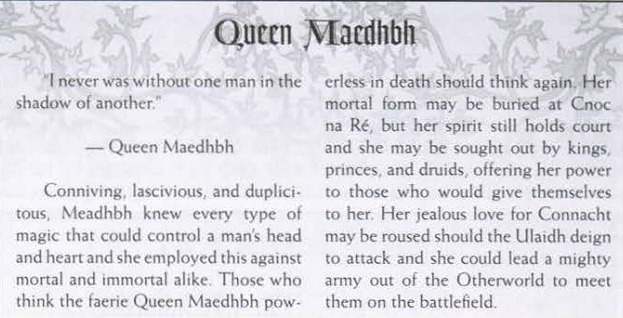
The village of Drumcliffe is home to the old druid Bran Bodhar, who spends his days in a tower. Rumor has it that he can see the future; rumor is correct, and indeed his power of divination is so keen that he can sometimes even see tomorrow, let alone big events. However, he is both deaf and illiterate, which can make getting information out of him rather difficult. Good luck with that! Connacht is also home to Loch na Sul, the site where the Fomorach king Balor of the Baleful Eye was slain by Lugh. His sling shattered Balor's eye, and the fire from the eye burned a hole in the ground. His blood filled the hole, forming Loch na Sul, the Lake of the Eye. The blood is gone now, but parto f Balor's eye remains, providing a Magical aura for the lakes. Were the eye to be removed, the magic aura would fade.
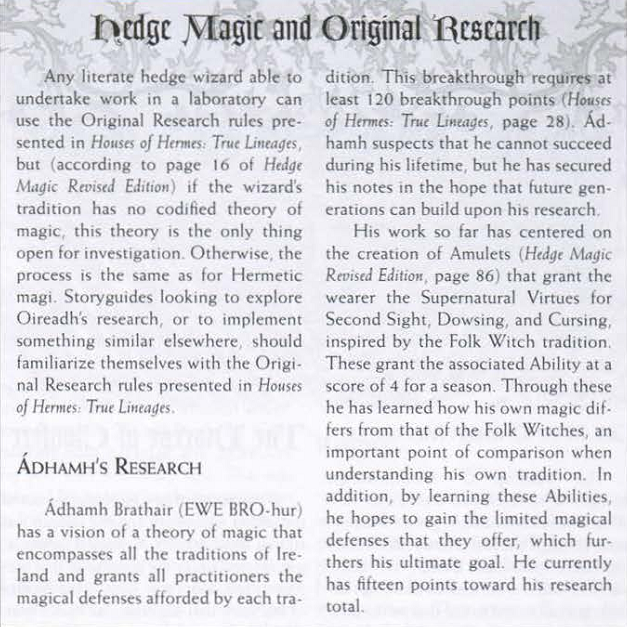
The Pact of Oireadh is a group of druids intent on inventing their own unified theory of magic, with the ultimate (and secret) goal being the creation of their own form of a Parma Magica. The druids were once allies of Praesis, hedge wizards who learned how the Order came to power and how they were protected from magic. They turned to their own research. The group has had trouble from the Gift, so they prefer to live far apart and meet each other rarely, using messengers to communicate. The more academic of the Oireadh have turned towards understanding the various druidic magics, but their research is kept secret for fear of the response of the Coill Tri and the Order. They have no love of the English. They do not discriminate between traditions - their number contains a Fir Bolg, a Witch, a Goetic sorcerer and a Learned Magician at the least. Adhamh Brathair is the LEarned Magician and founder, who sees his work as for a greater good which he will not see done in his lifetime. Umor Ard Mac Adar is a Fir Bolg of the Fir Domhnann, who bears the deformity of his blood in the form of an extra pair of arms and healing powers. He is otherwise handsome, if somewhat fearful of humans. Mor Greannach is the witch, a woman who takes her name from the thin beard she has. She is very old, and both revered and distrusted by her people. She knows quite a lot, and has many contacts among the druids. Tuathal an Iarrainn is the Goetic, and some distrust him and his magic, but he never hides his nature. He is a smith by trade, using his magic to bind spirits into the tools and weapons he creates, as well as seeking out resources to help research.
Praesis once stood between Connacht and Meath, but fell recently. Whoever takes it over, if anyone does, will have a hard time of it. Its cathach was the Gae Bulg, a spear made of the bones of the witch Coinchenn, slain by Art, son of Conn, and tipped by her clawed hand. If it should pierce a target, the hand closes over bone or guts, and the spear cannot be removed until the target is dead. Though Coinchenn herself was cruel and hideous, her daughter was beautiful and virtuous. The witch guarded her jealously, for she foresaw that the day she was wooed, Coinchenn would die. She beheaded those who came near and stuck their heads on spikes. Thus, the spear also grants the Death Prophecy virtue to its wielders. The prophecy differs for each, but it always begins with loss of the spear itself.
Praesis was built soon after the Treaty of Cnoc Maol Reidh, intended as a place where hedge wizards and magi could meet. Within a century, that was all but forgotten and its prestige waned. Later, though they were wary, Praesis took in the German Holzner of Tytalus in 1213. Two years later, he stole their cathach. They caught and killed him, hanging his head from the palisade. Word of this reached Ballack, Holzner's parens, and he came to seek justice. Convinced that Praesis would not be sanctioned, he decided to take the place by force, with the aid of others. He declared Wizard's War and struck. Praesis resisted the attack, so Ballack's forces stripped their vis and killed anyone approaching or leaving. The siege locked them away from the Tribunal, where they might have gained allies. It lasted a full year of standoff, in which many mercenaries and young magi died. The sides seemed evenly matched, but Ballack's nerve lasted longer. As the last of Praesis' allies fled, the magus Baetain Ua Traimair negotiated peace - the cathach for safe passage. The terms were accepted, and Ballack has ruled Praesis ever since. The former leader, Meadhbh, claimed sanctuary at the covenant of Qui Sunant Pro Quieto.
Now, there are six magi and two apprentices at Praesis. The magi are Ballack, who has contempt for the Irish magi but is out of resources and seeking a way for the covenant to pay for itself, Baetain, a Tremere and the traitor who gave up the cathach and who now lives in self-inflicted torment for the sake of rebuilding. Guillaime Flambeau of Normandy, an ambitious explorer and warrior, and Cacht cultas Criamoine, who killed for Ballack in the siege in order to destroy the status quo, but is now here only to kill time and, perhaps, help Guillame with Connacht.
Next Time: Leinster
Ireland is Dynastic
Original SA postEvil Mastermind posted:
Hell, White Wolf couldn't even reconcile the cosmologies.
Which wasn't so bad until Mage came out and all of a sudden it was all "wait, how come vampires and werewolves don't generate Paradox", "How the hell can vampires use their Disciplines to resist someone reshaping reality", and "why do werewolves and mages go to two separate spiritual realms?"
Man, White Wolf can't reconcile cosmologies within Werewolf , the sharks have a different and mutually exclusive cosmology from everyone else.
Ars Magica: The Contested Isle
Leinster is the southeastern province of Ireland, with the strongest links to England and Wales. Its people were the Laighin, descended from the uncle of Mil, Lughaidh mac Ith. They were formally founded when Labraid Loingsech, grandson of the high king, was forced to eat the hearts of his father and grandfather. They'd been murdered by his great-uncle, who became the next high king. From that day, he was either struck dumb or never spoke, until one day when he hit in the shins during a game of hurling and he said 'I am hurt!' Someone shouted 'Labraid', meaning 'he speaks', and that was forever after his name. Labraid was forced into exile and had many adventures, becoming the bodyguard of to the King of France, but he came home when an Irish princess sent him love poems. He returned with a bard and a druid, along with an army of men wielding blue-tipped spears from which the word 'Laighin' is derived.
Labraid's great uncle, High-King Cobthach Coel Breg, wanted to avoid a fight and gave Labraid Leinster, but he soon treacherously attacked. Labraid built an iron house at Din Rig, inviting Cobthach and thirty enemy kings to parley. They wouldn't enter until Labraid's mother and jester entered first, fearing (correctly) a trap. Both mother and jester willingly sacrificed their own lives when the house was chained shut and a fire built around it with the use of a magic bellows. The High King and his allies roasted to death, and Labraid took the throne. He was born with donkey's ears, which he hid beneath long hair, and he killed all of his barbers until one eloquently pleaded for his life and moved Labraid's heart. He allowed the man to live if he would tell no one. However, the barber whispered the secret to a willow tree, which was then cut down and used to make a harp. Whenever the harp was played, the tune sounded like 'Labraid Loingsech has the ears of an ass!' and, moved to shame, Labraid cut his hair and revealed his ears.
Leinster itself was founded by Ugraine Mor, a great high king of the Laighin stock, but for centuries was divided north and south. The Ui Cheinnselaig ruled the Wexford region and the Ui Dunlainge ruled Kildare, until the Ui Cheinnselaig united them in the eleventh century. It was the final Ui Cheinnselaig king, Diarmait mac Murchadha, who brought the Normans to Ireland. His intrigues led the high king Toirdelbach Ua Conchobair to send King Tigernan Ua Ruairc to despoil the kingdom and drive Diarmait to exile. Diarmait, of course, called on the Normans, as we know. After recapturing Leinster, Diarmait was devastated by the death of his son, Domhnall, and of course by marrying his daughter to Strongbow, he passed the royal line to the English after his death in 1171.
The western part of Leinster is home to the former kingdom of Ossory, home of the Osraighe - the Deer People. They descend from Oengus Osraigh, and they were a powerful kingdom until their defeat by the Ulaidh at the Battle of Tola in 571 and subsequent wars against the Vikings and Laighin that weakened them until their kingdom split into three parts in the 12th century. Their tuaths became part of the Kingdom of Leinster, but they have risen up to rebel against Strongbow. Their hostility has made them early targets for subjugation, and William Marshall has been subduing their lands and building castles. Their royal dynasty, the Mac Coilla Phadraig, or Sons of Patrick, one of their great kings, have largely accepted English rule and their name has been Anglicized to fitz Patrick. Many Osraighe remain hostile to the English despite the prosperity that has come to their lands, and they are particularly devoted to Saint Ciaran.
As we've noted, the Ostmen founded all the cities in Ireland. In Leinster, that's Dublin and Wexford. Their influence was fairly limited. They began to intermarry among the Irish, and by the 10th century they were essentially Christianized and assimiliated, though retaining large aspects of their culture, and by the 11th century they were speaking a Norse dialect of Irish. The Ostmen, while still known as Ostmen, are now extremely Irish.
Points of interest...well, there are plenty, but I am skimming over them. In Wicklow, there's a hill on top of which is a rath. Within the rath is a mound with a stone door, which usually has a very weak Faerie aura. The druids are said to have kept an eternal bonfire there, and at midsummer, a fire appears, which burns until the first rain. While it burns, the Faerie aura grows stronger. The fire is rich with Ignem vis, but any gathering it must defeat the inhabitants of the mound in a contest chosen by the fae, which changes each time based on the identity of the faerie tasked to guard the vis that year. Challenges of the past have included dancing, music, storytelling, climbing and javelin hurling, but there has never been a full repeat.
There's an abbey in an area called Glendalough whose abbot was once Saint Kevin, who taught Psalms. One day, one of his students fell sick and asked for fruit to ease his pain, but at the time there were no fruit trees in the abbey. Kevin prayed to God for health-giving fruit, and God granted a miracle. The monastery's cemetary was built near an old willow, which suddenly sprouted oblong white fruits, and filled with fruit within minutes. The boy ate of the fruit and was miraculously cured. This happened many, many years ago, but the willow still bears Kevin's fruit, as do the willows the monks planted around it the first year it recurred. The fruit appears on the date of the miracle and has healing powers, which the monks use to heal the sick. It is known as the Fruit of Saint Kevin and as many as 24 may sprout each season. Ancient tradition holds that anyone buried in the cemetary escapes Purgatory and goes directly to Heaven. The English priests mock this superstition, but many heroes have chosen to be buried here.
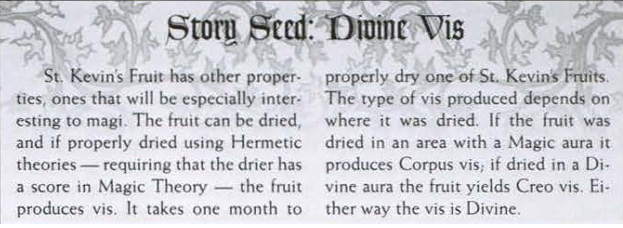
Nearby, the road paces a cliff waterfall that falls into a black, silent pool. The area is known to be haunted by a Puca or kelpie, a malevolent creature that appears as an attractive black horse that wanders, apparently lost. If mounted, it runs downt the road very fast and plunges into the pool, either drowning the rider or possibly eating them. While the locals know and avoid the beast, especially at night, no one knows if the kelpie is magical, faerie or infernal.
Leinster is home to the covenant of Ashenrise, founded by magi of the Normandy Tribunal. They are survivors of the fallen covenant Moles Magna and they hope to claim a dominant position in Hibernia so that they may update and civilize its barbaric Peripheral Code. To demonstrate the barbarity of Hibernia, they chose as their cathach the disinterred corpse of Rhiannon, former Prima of Merinita, who was buried in the Ui Riain homeland of Ossory. The magi acquired the corpse by convincing a local English lord, Raymond le Gros, that his vassals in the Ui Riain clan were plotting rebellion. In the chaos, they attacked the clan chief's rath and stole the body. In 1186, they announced their covenant: a FitzGerald castle they would be permanent guests in. It was scandalous, and Wars were declared, but the Praeco, Conan Deg, approved their cathach, ruling that the vis within the skeleton qualified. They defended it, with difficulty, for a year. The corpse is now enchanted to resist rot, and it can dance on command. The magi of Ashenrise feel this is an excellent demonstration of their point.
There is also the covenant Lambaird, meaning 'arm of a bard'. It's an old covenant, dating back to 826 and a pair of Flambeau. It is home to the school of combat magic known as the School of Raghallach, and has always been a Flambeau covenant. It is a strong protector of traditional ways, recently taking up the cause of protecting the Irish from the Normans, and have so far avoided sanction by claiming they are merely protecting themselves and their resources, though many suspect them of instigating raids. The cathach of Lambaird is a false arm made of silver. It was forged by a magical smith for a bard named Cairpre, and acted as a true arm. Cairpre was slain by a Lambaird magus the same year the covenant sought recognition. The magus, whose name has deliberately been struck from records, was enraged by one of Cairpre's satires and ignored the laws against harming bards. He was killed in a Wizard's War by his own pater, Petrifer, for his crime. The hollow arm is worn by one of the covenfolk over their true left arm, and wearing it is an honor. The arm is incapacitated, as the magic arm moves of a will of its own, animated, legend tells, by the spirit of Cairpre. Lambaird is a highly untraditional covenant, and its magi act more like noble lords than wizards or scholars.
The School of Raghallach focuses on overcoming defense with overwhelming power. Raghallach's druidic tradition used blood and self-inflicted pain to gain power, a technique known as cndmh greamu, bone-biting. The feat has since been lost, but the School is still expert in defeating supernatural foes. They study techniques to strip Magic Resistance or dispel it rather than avoid it, and are noted for stalking their prey to gain Arcane Connections before attacking - preferably blood retrieved on the weapons of their soldiers.
Another covenant of Leinster is the Paruchia of Nerius. A tiny number of the holy Celi De have joined the Order as part of Ex Miscellanea - just three, since 1189. Two monks and one manaim who live in the otherwise uninhabited island of Little Saltee off Wexford's coast. They were inspired by a vision that a Hermetic magus, Fedelmid of Limerick, had of the mysterious magus-saint Nerius while on pilgrimage to Rome. In the Alps, he found a valley where he had several visions. He sought out the secrets of Holy Magic and trained an apprentice, Indrechtach, who taught a manaim of his monastery. All three are Gifted, though Indrechtach's lack of Gentle Gift got him exiled from the monastery. The three have founded a new monastery-slash-covenant at Little Saltee. Their cathach is a holy relic of Nerus. Given the mystery around Nerius' martyrdom, it's unclear how Fedelmid found it, and it possesses three Faith Points and is kept in a small shrine. It is said to have worked miracles, but no one is entirely sure what its powers are, as the covenant keeps it secret.
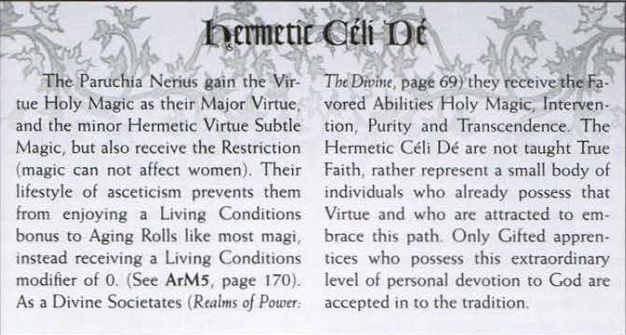
Next Time: Meath
Ireland is Compact
Original SA post Ars Magica: The Contested IsleMeath is the smallest provice in Ireland. It is a liberty know, and also known as the Kingdom of Mide, from the Irish word for middle. It is very significant despite being so small, though, and that is why it is a full province, not just a minor kingdom. Meath was founded by Tuathal Techtmar, son of an ancient Irish High King. When the four provincial kings rebelled against his father, his pregnant mother Eithne, who might also be Boinn, fled to Scotland. The King of Ulster became High King at the start of a two-decade famine, ended only when Tuathal returned to reclaim his throne via many epic battles. Once he conquered Ireland, he held a meeting at the Hill of Tara, where he established laws of the island and created Meath, centered on Tara, which would henceforth by the fifth province, the sole domain of the High Kings. In the late fifth century, the ruling Ui Enechglaiss were forced into exile to Arklow, where they can still be found, and the Ui Mael Sechlainn took the region, providing several High Kings. They are often known as the Southern Ui Neill. They have been forced to flee by the English, and the last king of Meath was deposed in 1172, when the kingdom was given to Hugh de Lacy, who held the territory until his death in 1186, despite losing Henry II's favor. Tighearnan Ua Ruairc, King of Breifne, dispute the claim and was killed, so Hugh's son Walter de Lacy eventually took Meath, and still holds it.
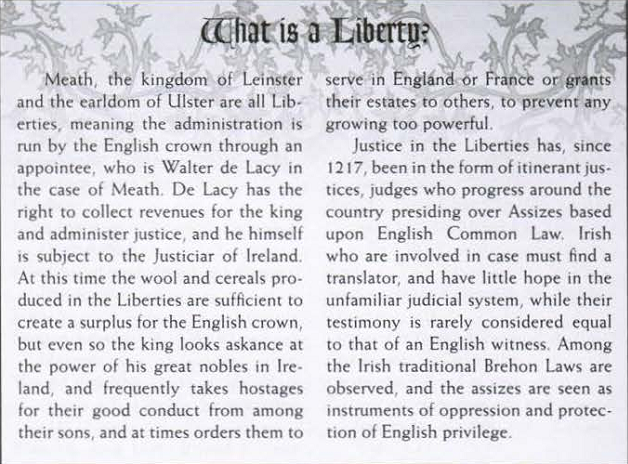
Near the town of Drogheda-in-Meath, an English settlement built by Hugh, is ?Mellifont Abbey, the most important Cistercian abbey in Ireland. It was founded by Saint Malachy of Armagh in 1140, on land granted by the King of Meath. It is mother house to Bective, Baltinglgass and 23 other Cistercian abbeys in Ireland. The first abbot, Saint Christian, was a major monastic reformer and worked carefully to help introduce the new diocesan system. In 1158, the king of Meath, Donnchadh Ua Maeleachlainn, was excommunicated and exiled and his brother, Diarmaid, became king at the instigation of a Mellifont synod. Mellifont dominates the Cistercians, and in recent years the English Cistercians and Irish ones have had tension. Rumors of corruption and debauchery in Ireland have rached Citeaux, the French mother house of all Cistercian monasteries, and in 1216 a vistation was sent to restore order and ensure the Cistercian Rule was being obeyed. On arrival, the Mellifont monks denied their superiors access, an unprecedented move, and it's sent shockwaves throughoput monastic Europe. The event is known as the Conspiracy of Mellifont, and while the Cistercians of Citeaux nominally deposed Abbot Thomas, he is still in office at Mellifont. The Cistercians are preparing a disciplinary deputation, and even the papacy may become involved.
Then, of course, we have the Hill of Tara. Tara is a very, very important place, though in 1220, it lies neglected and overgrown despite its fame and legend. The Ui Mael Sechlainn named themselves the Kings of Tara, at leastu ntil their fall against de Lacy, but it was a purely ceremonial title. Tara was of great importance in the past, but in the sixth century, Saint Ruadan cursed King Diarmait with a prophecy that he would die in his own hall here, after Diarmait took men from sanctuary in Ruadan's church. Diarmait's hall caught fire, and a beam fell and slew the king, exactly as predicted. From that time, it is said that no hall could be raised at Tara due to the saint's curse. The faeries of Tara play out ancient talls - Aillen mac Midgna burning the hall, Fionn mac Cumhaill driving him off - but mortals rarely visit. Not never, however - every seven years, Tara is home to the Hibernian Tribunal. The hill itself is wide and shallow, surrounded by raths and ancient (often magical) features. It is a very, very magical place, with a potent Magic aura, with the exception of a single mound, the Mound of Hostages. This mound belongs to the Tuatha De Danann and has an exceptionally potent Faerie aura, which encourages respect. Every Samhain, the time when sacred fires were once lit here, the auras of Tara grow even more potent. The greatest king of Tara was Cormac mac Airt. Cormac ruled centuries ago, and had the service of the hero Fionn mac Cumhail. His reign was a time of great prosperity, and many of the earthworks of Tara date back to his time.
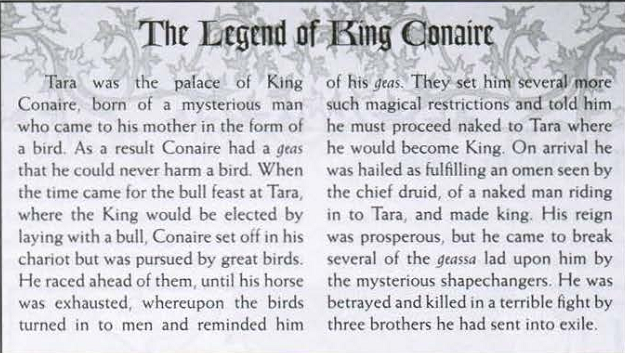
The rath known as the Hill of Tlachtga holds the sleeping daughter of Mug Ruith, the druidess-faerie Tlachtga. Mug Ruith still visits it from tiem to time via his wonderful flying machine, and his daughter occasionaly leaves her sidh to converse with mortals who come to the hill. Her story is quite tragic - when Mug Ruith was studying with Simon Magus, she was his assistant in the creation of the flying machine. One night, Simon raped her and she fled to Ireland, causing her father to break with Simon before his death at the hands of Saint Paul. It was at home that Tlachtga gave birth to the triplets Doirb, Cumma and Muach, then entered the hill and withdrew from the world. Every Samhain, Tlachtga was remembered when the druids lit sacred fires on the hill, and the rath was one of the royal sites of Meath. The rath atop the hill is a great one, and in 1168, Ruaidri Ua Conchobair held a great gathering there, though Tlachtga did not emerge for it. In 1171, Tighearnan Ua Ruairc of Breifne came here to parley with Hugh de Lacy. Under flag of truce, the two met, but a fight broke out and de Lacy's interpreter was slain. De Lacy fled, and his men slew Tighearnan as he tried to flee what may well have been a conspiracy to kill him. Despite all of this, Tlachtga did not emerge.
Meath is also home to the town of Kells, not to be confused with the KElls of Leinster, which was briefly the center of a short-lived diocese but is best known for its monastery, founded by Saint Columba, and its church, founded by Saint Patrick. The town grew around the abbey and is ruled by the abbot. The monastery is home to two very famous books. The first is the scathach of clan O Domhnaill, an ancient psalter they carry to battle and keep here for safety. The second is the Book of Kells.
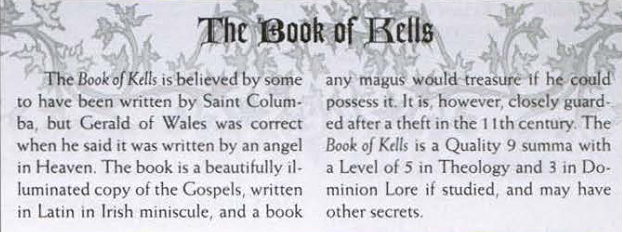
The mystical center of Ireland is also within Meath: the Hill of Uisneach, where all five provinces meet at Ail na Mireann, the Stone of Division. The stone is an Arcane Connection to the five provinces, assuming anyone was ever audacious enough to try to cast a spell on the entire province. It is here that the druids once lit a great fire each Bealtaine, which could be seen all the way to Tara. It s was here the Milesians met Eriu, Banba and Fodla, and Eriu's name was given to the island: Eire. Saint Brigid took her nun's vows here as well as her bishop's vows. Many of the Tuatha De Danann slumber below the sidh that dot the hill, and many of the stones of Stonehenge were stolen from the hill by Merlin. To this day, the site has a potent Magic aura. The Stone of Division is a tradition place for oathtaking and treaties that govern the entire Tribunal, and in the early days there was a covenant here. It vanished one night without a trace, and now only fragmentary records of it exist, even its name forgotten. Folk stories speak of a potent magician who saught to rule all of Ireland, but who broke a geas and was taken by the faeries. The truth is obscure. It is likely that a covenant will once again be founded there eventually.
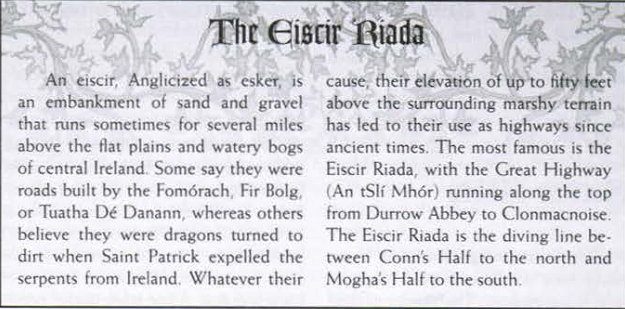
Next time: Munster
Ireland is Cheese
Original SA post Ars Magica: The Contested IsleMunster, aka Mumhan, is the southern province. Originally it was split into Desmond, Thomond and Ormond, but much of it has been renamed and redistributed to English lords. The Irish kings in the east keep English knights and retain native privileges in their ancestral cantreds, but English lords impose English law elsewhere. The foreigners and Ostmen of the cities are in theory ruled by the English but in practice do as they will. Outlaws live in the forests and prey on everyone.
Munster was the first land claimed by the Milesians, given to Eibhear Fionn mac Mil, whose descendants divide into several tuatha. The Eoghanachta are named for Eoghan Mor, and they were the strongest clan for centuries. They seperated, however, into several clans over the years. The most potant are the Eoghanachta Caisail, in Cashel, the Eoghanachta Aine, in Cnoc Aine, and the Eoghanachta Locha Lein, at the Lakes of Killarney. The Mac Carthaigh are the most potent of the Eoghanachta Caisail, and the current rulers of Desmond. Once, they ruled Cashel, but were driven west by the Dal gCAis. The English pushed them even more west, past the River Bandon and Kinsale. The hate the Ui Briain and the Ui Suilleabhan f Kerry even more than they hate the English; the Ui Briain are too strong to attack, but the Ui Suilleabhain are not. In 1214, at a peace negotiation in Raheen, the mc Carthaighs slew several nobles of Ui Suilleabhain, though the victory did not last, as it was only a year before the two most potent Mac Carthaigh, Diarmait and Cormac Fionn, were at war. The Ui Suilleabhains themselves are Eoghanachta Caisail, descendents of a seventh century king. Their most famous king, Fedlmid mac Crimthainn, was king of of Monster and the abbot of Cork and Clonfert abbey. While the massacre has set them back, they are still strong enough to fight the English.
The Dal gCais, or tribe of Cas, moved north as they grew stronger, settling east of Limerick before heading north up the River Shannon. Eventually, that area and the land between the Shannan the Fergus as well the south shore of Liugh Derg would become the kingdom of Thomond. The Dal gCais claim their success comes from both Saint Patrick and and the faerie land goddess Aoibheall, who lives on the shore of Lough Derg. During their first migration, Patrick visited the tribe and they built the church Singeal, 'chancel', on the site. Saint Patrick often visits the clan, for they are his favorites. The mound of the faerie goddess, Craig Liath, is located on the western shores of Lough Derg, and every king marries Aoibheaill in a public ceremony. If the king is good and the clan prsoperous, she provides foresight, wisdom and prophecy. Aoibheall doesn't spend much time with her husband, who generally has a mundane wife. In 1220, both the sacred sites of the Dal gCais, Singeal and Craig Liath, are held by others. The English and Ostmen hold Singeal, while Connachtmen hold Craig Liath. The most potent of the Dal gCais are the Ui Briain, named for Brian Boramha, though their rise first began with his brother, Mathgamain mac Cennetig, and his conquest of Cashel and Limerick. The brothers fought constantly until Methgamain's death, and Brian eventually became so powerful that he claimed the high king ship. Brian married Aobheall, as expected of him, and some suspect this is what raised him to power, and that without her foresight, he'd never have been the ard ri. Her divination is, after all, so accurate that many refer to her as bahfhaidh Ui mBriain, the prophetess of the Ui Briains. Legend has it that she visited Brian on the eve of the Batle of Clontarf and told him he would die there.
There is also a collection of clans that were once vassals of the Eoghanachta, who live in the area north of Waterford. These are the Deise, who lived near Tara until Cormac mac Airt drove them out when their founder, Aonghus Gaifhuileach ('bloody spear') quarreled with one of Cormac's sons over a woman. When the English came, the Deise joined with the Ostmen to protect Waterford, but failed even so. They now respectfully serve the English by day and cause as much chaos as they can under cover of night.
In 1210, King John gave his favorite lords land in Munster, but retained control of Waterford, Limerick and Cork. The lands north of Waterford were given to Robert le Poer, Thomond to Philip de Braose and Desmond to Robert FitzStephen and Milo de Cogans. None of them were able to claim those lands, and in 1220 their sons have only limited control over Munster. Hostile neighbors and lack of military success have checked their ambitions. The English offer military assistance to the Irish in their internecine battles, and both Desmond and Thomond have had recent succession wars, with each faction hiring English mercenaries. Confusion and violence have allowed the English to very slowly encroach on Desmond, and the English still readily fight each other - land is land, after all. The cities aren't much safer - the Ostmen rebel constantly and Limerick cannot control them, so they raid the countryside indiscriminately.
The island of Tech Dairbhre is just off the Munster coast, connected by a slim isthmus. The faerie Mug Ruith lives there, having proclaimed himself the most famous druid in Eire, and is court wizard to King Mbod, leader of the Munster Tuatha De Danann. He owns a flying machine, the roth ramach or 'oared wheel', and goes about in a bull hide and bird mask when riding it. He regularly visits Tlachtga in Meath.
The river Shannon in Thomond is the longest in Ireland - almost 250 miles long, from the Dartry mountains to the Atlantic. It is named for the goddess Sionainn, who was a mortal woman that found a faerie well that gave knowledge. She removed the capstone and was overwhelmed by the rushing water, drowning her and forming the river Shannon. Transformed in the process, the faerie Sionainn now travels the river in a small hide-covered boat, overseeing it. The entire river has a very weak Faerie aura. In remote areas, that aura grows stronger, and some pools or eddies contain regiones. Faeries are more dangerous west of the Shannon, and malevolent fae are common.
Thomond is also home to the church of Saint Flannan. Flanna was an abbot of the 600s and the Kilaloe monastery, a nephew of the Ui Briain king. He had holy powers of divination, and he led his community well. He was canonized after death and Thomondmen still travel to his grave for guidance. A cathedral, yet unfinished, was begun in 1185 to honor him, and the foreman claims the saint visits him nightly with helpful advice and instruction. Next to Saint Flannan's relics are Saint Finbar's, relocated from Cork. In 1220, the cathedral is nearly done. A few yards from its foudnation is the Ogham Stone, on which a message is carved in Ogham: A Blessing on Thorgrimr. On the back is the signature 'Thorgrmr carved this cross' in Nordic runes. The stone is at least two centuries old and no one knows more than what it says - many not even that. While the stone is magical, the proximity to the cathedral has kept it from being stolen and studied. It represents some kind of connection between the druids, the Norse wizards and Christianity.
The Liberty of Tipperary, once Ormond, is a boirder kingdom full of Eoghanachta septs...and more importantly, Sidh Femen, the home of Bodh Derg, son of the Dagda and king of the Tuatha De Danann of Munster. This mound is a vast underground complex with all the trappings of a royal court - from minstrels to swineherds to warriors and wives. Bodh Derg is famous as a judge and dream interpreter, and other faeries often visit him. His smith, Len, makes magic items for them. At the end of the day, he hurls his anvil to a hill and, where it lands, the sparks from it become pearls. These pearls normally disappear when Len retrieves his anvil at daybreak, but one night per year, they remain and can be collected for Ignem vis.
Munster is home to the first covenant of Ireland, Circulus Ruber, which is also the largest and certainly the most vocally self-appreciative. They are traditionalists and they have no interest in changing their ways. We know how they were founded, and they've lasted a long, long time. They defend Irish culture and the current Code, and have so far ignored the English invasion as inconsequential, though not the English magi. Their cathach is the magic cauldron first found by the founders. It is not, as was originally thought, the Dagda's, but instead the Cauldron of Llasar Llaes Hyfnewid, a giant that lived under a lake. The Dagda's Cauldron reportedly produces infinite amounts of food and drink; Llasar Llaes Gyfnewid's CAuldron revies the dead so they may fight for one more day. Legend has it that it was traded byween the Irish and Welsh kings before being broken in a war; either the legend is wrong or this is a similar but different cauldron. Few know the cauldron's true power, which is kept secret. It will revive a dead warrior as long as the head and spine are intact. The warrior cannot speak, but will fight ofr 24 hours under the command of whoever put them in the cauldron. It cannot revive a corpse a second time. The magi of Circulus Ruber encourage the formation of new covenants and see themselves as the defenders of Hibernia. They like combative magi, and encourage Wizards' Wars, to the point of loaning magic wepaons out to help. They may love violence, but they also protect the sacred sites, mounds and other important areas in the Tribunal, support the Tribunal's Mercer Houses and sacrifice their time to aid the community. Both the Praeco, Milvia of Bonisagus, and the Presiding Quaesitor, Visoturpis of GHuernicus, live in Circulus Ruber, as does the oldest magus in Hibernmia, the 172-year-old Conan Derg of Merinita, the former praeco.
Cliffheart is another local covenant - magi interested in studying faeries. They are rather paranoid due to regular interactions with the fae. They are staunchly traditionalist, and refuse to accept English magi or changes to tradition. They are trying to find a way to do magic in Irish, not Latin. Cliffheart was founded by three Merinita after their former covenant, Cosan Ceolaire, was destroyed in the Schism War. Most Merinita didn't take part in that, but those three fought because of Diedne's alliance with the Munster Tuatha De. After the final battle, they movedd to Cape Clear Island, just off the southwestern shore. Cliffheart has never learned why the Tuatha De sided with House Diedne, and fearing that it could happen again, with Teach Duinn so near and Donn's history, they continue to study the Tuathe De Danann. The original three are all gone, but their students continue their work. Their cathach is made of three standing stones. One of them is a Diedne magus, turned into a stone obelisk. It has a hand-sized hole through it, which they claim is a fatal wound. They annually renew the stone spell, for ifi t were to end, the magus would instantly die. Community members in the area refer to the stones as the Marriage Stones, thinking that if a man putsh is hand through the hole to grasp a woman's hand, the pair will remain together forever. The monks prevent couples from doing it, claiming the practice is evil and pagan. Both monks and couples have caused minor problems for Cliffheart before. The covenant is a huge mess, because Irish fae hate disorder. No member of the covenant cuts their hair or beard, they wear iron rings on both pinkies and necklaces of horses' back teeth, thery destroy eggshells so small faeries cannot live in them, they forbid cats and dogs entering, the make huts have front and back doors aligned, so that faeries will keep moving through them, theyn ever dig holes in the ground of a rath, never trim bushes or trees, sprinkle sale urine on every door threshold and never start work or journeys on a Friday.
Elk's Run is another covenant, founded only decades ago. They are meant to embody the best traditions of the Hibernian magi. When Oswald of Bonisagu and Lugardis of Huernicus arrived in 1159, they had cattle, silver and vis sources, as well as a pair of giant elk antlers meant as their cathach. They claimed the right to found their covenant in a remote valley, building a tower. Soon after, a dispute arose, as several covenants demanded to see their cathach. Oswald, while not a native, was ready and produced antlers which he claimed belonged to a true Irish elk, a seven-foot beast which he'd hunted and killed - a feat formerly done only by the Fir Bolg heroes that hunted the elk to extinction long ago. Oswald found them, he sad, in a FAerie realm while performing an ancient story. As those antlers are sometimes found in bogs, the magi were not convinced, though the cathach did radiate magic. It was clear these newcomers, however, were here for trouble. Oswald was English, and Lugardis clearly wanted to impose English rule, they felt. They were close to Connacht and could not be trusted. The Irish therefore challenged their claim to the local vis, arguing that by ancient tradition and agreement they belonged ot others, though strictly speaking, such a claim had no merit. Oswald was ready for this. He issued a challenge: that all the vis and land he could circle before sunset should be his. The Irish laughed, for it was late, and agreed. No spells, they warned. Oswald agreed and took his cathach, hurling it ot the ground. A great elk appeared, towering over every man there, and Oswald climbed upon it and rode off to the mountains, as the Irish realized they'd been tricked. The elk feeled trees rather than go around them, and as the sun set, Oswald returned, having earned Elk's Run. Many of the Irish felt he'd been amusing and easily shown his right, but others were angry., Many came to raid in their Macgnimarthas, and some even after. To date, none have taken and held the cathach long enough, for Oswald is still very, very tricky. Other than the power to become al iving elk, no one has any idea what its powers are besides Oswald. All three magi of Elk's Run and both apprentices are from Stonehenge.
The Mercer House of Leth Moga can also be found in Munster. It is sister to Leth Cuinn, serving all covenants south of the Eiscir Riada. Since it began, it has been interested in history. The northerners are more martial, but Leth Moga are the historians and witnesses of the Tribunal. They are not a covenant, and have no cathach or cattle. They exist to serve the Tribunal and are safeguarded by the Peripheral Code. Both Leth Moga nad LEth Cuinn formed in 898, during the first Tribunal meeting. The Redcap Imag, wife of the Abbot of Clyone, offered land and leadership and was given the right to build Leth Moga. Her husband, Cian Ua Cathain, led the monks and staff, while Imag ran the Mercer House. She recorded the Tribunal history in monastic traditioin, writing the Red Book of Cloyne, and all subsequent leaders have done the same. Initially, it was publically available, but after the Schism War, then-leader Fergal mc Cuirce restricted its viewing, feeling that the Schism War should be forgotten by literally closing theb ook on it. Now, only Redcaps could read it. In the 1100s, some magi complained to Fergal's son-in-law and successor, Diarmait, that the Red Book should again be made available, but Diarmait ruled that it fell under the protection of his sanctum marker, and the Tribunal ruledi n his favor.
Next time: Ulster
Ireland is Northern
Original SA post Ars Magica: The Contested IsleUlster (or Ulaid) is the northern province. In the days when the king Conchobar mac Neasa ruled from Emhain Mhacha, the Ulaidh - that is, the Ulstermen - gave Ireland some of its greatest legends. These tales from the Ruadhraigheacht, the Ulster Cycle. None of the kingdoms in the current age have an Ulaidh king, but they are still proud of their heritage and very coherent for a people so long under 'foreign' kings. Ulster has long been known for war, and it was from the north that the Tir Fhomoraig, the Land of the Fomorach, once stretched out and dominated the island. Once they were driven off the land, it was settled by the Erainn.
The Erainn descend from Mil Espaine, and were a vassal tribe of the Connachta that hung on longest in the north. They worshipped Daire (a name of the Dagda) and Macha, a goddess of rulership andh orses. The greatest of their kings was Conchobhar mac Neasa, whose reign was a oglden age. He was the model of a good king - wise, amorous, fierce and generous. The Ulster Cycle, which tells of his time, has four great themes: the war with the Connachta, the rivalry of Conchobhar and Fearghus mac Roich, the contest of two bulls and the exploits of Cu Chulainn. Legend has it that Conchobhar died on the very day of Christ's crucifixion, from a magically inflicted wound. Only his body died, though, for God had placed his soul in his skull. When, centuries later, Saint Patrick preached in Ulster, he heard Conchobhar's soul crying out and was moved to tears. The saint's tears baptized the old king, and his soul finally found Heaven.
The struggle of Ulaidh against Connachta was ultimately futile - the Connachta were just too strong. The Ulaidh had to cede land to them, retreating east. Four sons of High King Niall of the Nine Hostages headed north from Tara, and two of them occupied land in western and central Ulster. The nine hostages refer to the nine subkingdoms of Airgialla in Ulster that came under Connachta control, as each gave a hostage to prove their peaceful intent. While the common men of Ulster are Erainn under Connachta kinga, the true Ulaidh are the Dal bhFiatach, who ruled the east from Downpatrick until the English came. The Dal bhFiatach were alternate allies and rivals of the Dal nAraidhe, who occasionally ruled the province. The purity of the Dal bhFiatach is found in the fact that some families still suffer the Birth-Pangs of Macha (of which more later), a curse levied on true-blooded Ulstermen in ancient times.
The Cruithnigh of Ulster were not descended from the Milesians. They came from Scotland, where they are known as Picts, hunting for wives, for they had no women. Eireamhoin mac Mil gave them the widows of dead Milesians, on the condition that the Cruithnigh would have women as their leaders, a tradition they have since kept to. Their kingdom of Dal nAraidhe covered the northeastern part of Ireland, the Isle of Man, and even into Kintyre and other parts of Scotland. Their power was already waning when their druidic priesthood was crushed between the forces of Diedne and those of Pralix. With a few tuyatha of the Dal nAraidhe in northern Ulster and even fewer in Drogheda, the remnant Cruithnigh population can be found scattered in northern and western Ireland. On average, they are slightly shorter than the Gaels and tend to darker hair and eyes. They have a fondness for multicolored clothes and for tattoos. At least in Tir Fhomoraigh and maybe elsewhere, there are a few pockets of pagan Cruithnigh, and the priests of their religions are identical to the gruagachan of the Picts.
The Norman knight John de Courcy was given Ulster by the King of England, if he could conquer it. He took that seriously, marching on Ulster with 22 knights and around 300 soldiers. He passed through Meath and Airgialla, and on February 1, 1177, he took Down by surprise. The king of Ulster, Ruaidhri mac Con Ulad Mac Duinne Sleibe of the Dal bhFiatach, could not face de Courcy on the field due to the curse of Macha's Birth-Pangs, and instead he fled to collect an army, returning after a week, when the curse had passed. The Ulaidh were panic-stricken by the sight of Englishmen and horses in full battle dress, and the English routed them. Even when they were supported later by the Cenel nEoghain, de Courcy defeated them and secured lordship of all land easy of the River Bann. In 1196, he defated the king of Tir Chonaill and took tribute from that land, and after his brother's murder by an Irishman in 1198, he ravaged northern Ulster in vengeance. Much of lkster was under his control from this, but his fall came when his old foe, King John, took the through in 1201. John de Courcy had allied with King Cathal Crobhdearg Ua Conchobhair of Connacht, and in 1203 he was arrested on charges of rebellion against the crown by Hugh de Lacy, younger son of the Lord of Meath. In May 1205, King John named Hugh the first Earl of Ulster, giving hom dominion of all lands that de Courcy had held on the day of his defeat.
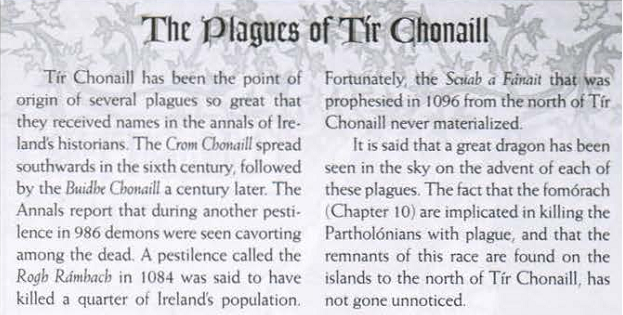
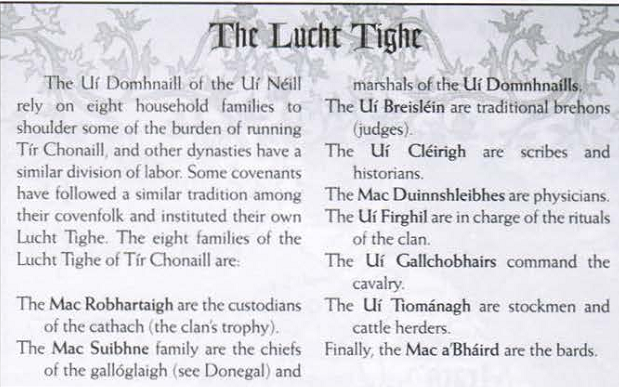
The Poisoned Glen is on the coast of Ulster, facing Toraigh Island. It is the remnants of the power of the fomoir champion Balor of the Evil Eye, who sat atop his tower on the island and glared at Ireland. In the mouth of the glen is a standing stone, said to be a warrior turned to rock by Balor for his impudence. The Glen has a weak Magic aura, though some parts might be stronger. The Seven Sisters are a series of mountains whose slopes create the Poisoned Glen, and the tallest of these is An tEaragail, or Mount Errigal.The Glen is black and scarred, and little grows there.
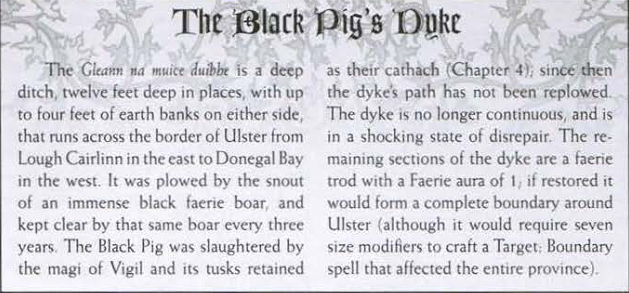
Near Armagh, there is a hillfort named Emhain Mhacha. It was the ancient seat of the Ulster kings, home to Conchobhar mac Neasa and the Red Branch Knights. The connection to the goddess Macha is evident in the name - she was the chief goddess of the Ulaidh, associated with war and horses, and an aspect of the Mor-Rioghain. The palace there was named Charobhruadh, the red-branched edifice, and was a great building supported by red yew. However, at some point long ago it was filled with boulderes at least six feet high and then set on fire, though why is not nknown. Many have come seeking the gold supposedly hidden in the roof. To the east are the remnants of Bron Bherg, the house of sorrows, said to be the first hospital, built by Macha Mhuingruadh and uses continually until its destruction in 22 AD. To the northeast is Loughnashade, the lake of the treasure, where sacrifices to the gods were made - gold, horses, severed enemy heads. Finally, in the northwest, are the King's Stables, where the sacred horses used only by the king were kept. Their descendants still roam Armagh and some of them are fiorlaindhe. (More on that later.)
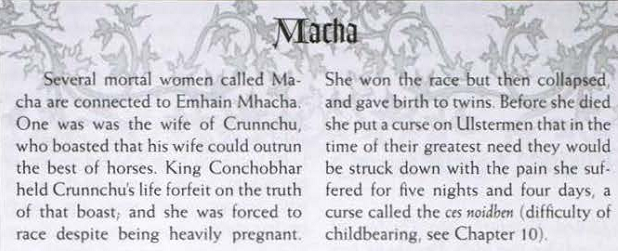
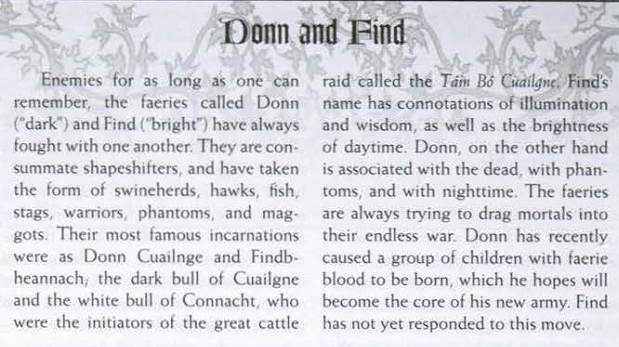
Near the castle of Belfast is the Giant's Ring, a huge earthwork nearly 200 paces in diameter. Its bank is 15 feet high, with three gaps in it. It is made not just of earth, but also 12-foot stones, placed in Irish style with their sides touching. East of the circle's center is a small tomb. The Ring has notable Magic aura, and is the meeting place of the Irish giants, though they haven't met in centuries. If a magus wants to get in touch with a giant, they should carve the giant's name in ogham on a stone and palce it in the tomb. The giant will send a messenger to them within forty days.
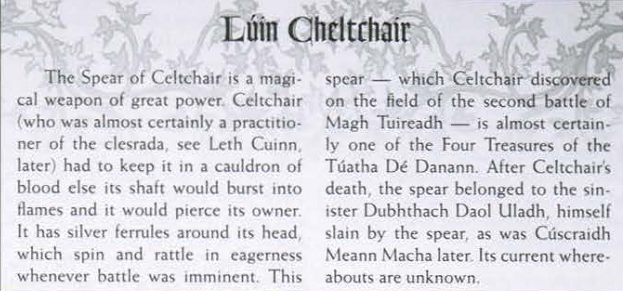
Tir Fhomoraig, the Kingdom of the Fomorach, has been located on the isles north of Ireland ever since they were cast out after the Second Battle of Magh Tuireadh. The greatest strongholds of the race are Rathlin Island and Toraigh Island, but some say they can be found as far asway as Islay and Arran of Scotland. Since they've left, the birth rate of pure-blood fomorach has plummeted to nearly nothing, and while they cannot age, they can still die of wounds or sickness. There may be fewer than a hundred fomorach left, and the number is not growing. The King of the Fomorach is Madam Muinreamhair, MAdan Thick-Neck, and he has no love of humans, for Nemed slew his four sons. However, he has come to realize that their blood might save his race, and he seeks to arrange marriages with the Cruithnigh of Rathlin. His people hate these half-breeds, but they may have little choice if they wish to survive.
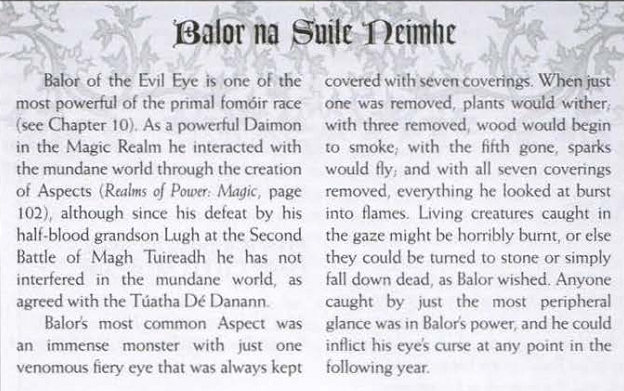
Next time: Leth Cuinn and the Clesrada
Ireland is Fisty
Original SA post
Do you like awesome martial powers?
I sure do!
Ars Magica: The Contested Isle
Leth Cuinn lies in Ulster, the second Mercer House of the Tribunal. It is not a covenant and has no cathach, like Leth Moga. Since its creation in 898, it has focused on martil pusuits, but this has dramatically turned since 1029, when Daire Farranta returned after seven years' absence and challenged his parens, the leader of Leth Cuinn, to Wizard's War. It was won with no spells cast, since neither was Gifted, but Daire defeated his parens with remarkable feats straight from legend -the clesrada. The remaining Redcaps were exiled, and Daire filled the place with his own kind, including the faerie Uathach, who had trained him in the clesrada. Daire Farranta turned Leth Cuinn into an outpost of the Mercere Cult of Heroes, and it is still run by his descendants. Leth Cuinn trains Heroes and teaches Redcaps the clesrada, as well as, for various trade deals, grogs and companions of other magi. They generally trade for longevity rituals, spells they need cast and enchanted items.
The clesrada are easily the most obvious tradition of Leth Cuinn, and every one of its members belongs to the Cult of Heroes. They are trainers of great skill, though also renowned for their terrifying demeanors. Seven Redcaps, none Gifted, run Leth Cuinn, and the leader is Daire Cu Ua Daire, the current consort of the faerie Uathach. Five of the REdcaps are his children, and the last is his nephew. Daire inherited the job from his father, Daire Direach, and is groming his eldest son, Daire an Chogaidh, to take over for him. Since the death of his mortal wife, his marriage to Uathach has been more than symbolic. He despises Leth Moga, and finds them too doddering and bookish to be good Redcaps. His son hates the English and all of their ways, and has even voted at Tribunal against them despite Mercere traditions. Rumor has it that the Primus of Mercere is preparing some kind of response for him.
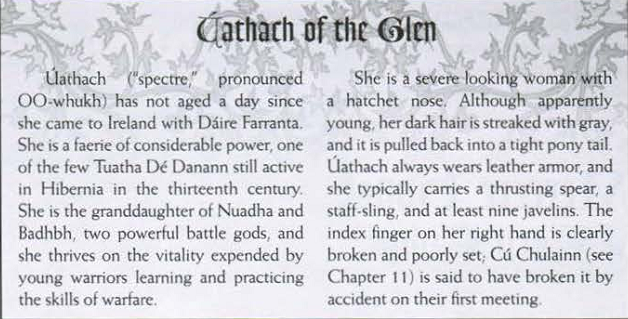
So, what are the
Clesrada
? The heroes of Ulster were famous for their martial skills - mixes of skill, agility and magic. Each cles required great practice, and their use by the Ulster heroes was a matter of fear and awe. The original clesa are said to derive from the sidhe lord Lugh, called Ildanach, skilled in all arts, for his work. The most famous user of them, however, was his son, Cu Chulainn. He is said to have mastered all of the clesa, including one that none other than his own son could learn - and he taught the boy that trick himself. Clesrada means 'feat of amrs', and they were taught to the Ulaidh heroes by Scathach, the daughter of Nuadha, who ran an academy on the Isle of Skye. She was aided by her three sons Cuar, CEt and Cruife. Cu Chulainn studied with her for a year and a day, becoming the lover of her daughter, Uathach, who is now the only known teacher of clesrada. (I personally would allow other cultures to get similar shit via other mythic teachers, like Chiron.)
Each cles must be learned seperately, and each requires an initation under the guidance of Uathach. She lays a geas on all those she teaches to never teach anyone else, with the penalty being the loss of all clesa. This is in addition to the gaes that is part of the initiation. Anyone can use any cles they know as often as they want, and most of them have no cost to use. Each, however, requires a roll to use successfully, and any botch always costs the user fatigue as well as potentially other consequences. Clesa are supernatural abilities associated with Faerie, and each is equivalent to casting a level 15 spell, with Penetration equal to your Penetration bonus. Spells that affect magic beign cast can affect a cles. Clesa enhance your skill, but do not directly affect your wepaons or opponents, so they do not need to penetrate Magic Resistance. However, someone under the effects of a cles is considered magical, so, for example, your unarmed attacks
can
be resisted. However, since most clesa last only moments, this is usually not a big deal.
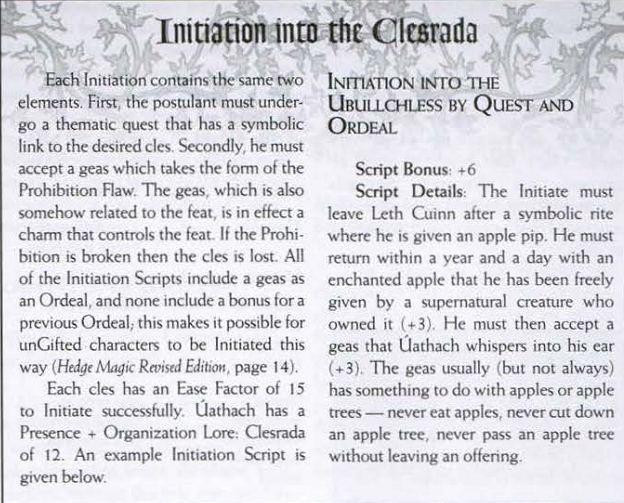
Some clesa can be used together - you can use any number at once if they all use the same skill, and they will merge together into a seamless, single action. Each takes place in order, and you must roll for each one. The first failure breaks the chain at that point, and you cannot take any ohter action the round, including attacking. So, for example, you might use Profit of Speed to catchh up to a horse, Hero's Salmon Leap to jump on its back and Rope Feat to keep your balance while it ran at full gallop, all in one round. You could not, however, use Apple Feat in the same round to prepare for a sling attack, since that uses Thrown Weapon, not Athletics, and you could not use Wheel Feat to hurl a shield from horseback, since that takes an attack, not just a feat roll.
Athletics Clesa
do not normally involve direct attacks. The ones they list are examples, but you could easily invent more. The ones listed are based on the Ulster Cycle. They include:
Bai Brasse, the Profit of Speed
: You hurry at three times walking speed, or run at six times walking speed, for a single round. Normally, a hurry is twice walking speed and a run four times walking speed.
Cless Caitt, the Cat Feat
: You jump horizontally from a standing start a distance of up to eight times your height, though encumbrance can shorten that.
Ich-n-Erred, the Hero's Salmon Leap
: You jump vertically from a standing start a distance of up to four times your own height, though Encumbrance can shorten that.
Ochtarchless, the Eight-Men Feat
: You get +5 to strength (and note: 5 is as high as any human being's Strength can
get
) for the sole purpose of lifting something or supporting its weight. Once the object is lifted or supported, your strength is sufficient to hold it each round you continue to make the feat roll.
Rothchless, the Wheel Feat
: You can hurl something you normally would not be abl to. Classically, a chariot wheel. You have to make a Thjrown Weapon attack to hit something with it, but the thing will deal damage based on how big it is, and will probably break whatever it hits.
Tetchless, the Rope Feat
: You can balance and stand upright on an unstable object smaller than your own foot, and even move your normal speed on it for a round. The roll is harder the more unstable the thing is, but a moving horse, a rope slung between two poles or a staircase banister are all fairly easy, while, say, walking up a grappling rope hangign from a wall would be a bit harder. You have to make the roll each round you're not standing on a stable object bigger than your foot. If you ever fall, you can make an easy roll to land on your feet, ignoring most of the fall damage.
Concentration Clesa
use meditation and focus to brin the body beyond normal limits. For example:
Cless For Analaib, the Breath Feat
: You can hold your breath for extended periods, and need to make deprivation checks only once every five minutes rather than once every thirty seconds. You may also get a bonus to activities requiring great precision by holding your breath through the task, including aiming ranged weapons. Tis lasts until you do something else other than a Concentration cles.
Corpchless, the Body Feat
: You can controt your body within the skin to escape bonds or pass through small spaces, dislocating and relocating bones. Escaping shackles is fairly easy, while wriggling through a space a size category smaller than you is somewhat harder, while one two size categories smaller is very hard. Resetting a joint takes a round per joint, and most uses of the cles only dislocate one or two joints. Until reset, the limb is useless. You can also use this power while wrestling to get a bonus to escape a grapple.
Saebchless Diberge, the Wild Feat of Contortion
: You can contort your limbs and back unnaturally, striking from unexpected directions, like over your foe's shoulder or behind your foe's knee. This gives a bonus to attacking for any special maneuvers, like trips or disarms, or a bonus to resist such maneuvers.
Siaburchles, the Phantom Feat
: You concentrate as a foe strikes, offeirng no defense. If you succeed, part of your body becomes momentarily insubstantial, causing the foe's blow to pass through you harmlessly. You cannot become wholly insubstantial, and you can't do this feat two rounds in a row.
Weapon Clesa
use either Single Weapon or Great Weapon depending on how you learn each feat, chosen at the time you learn it. No penetration needed - the magic is in your skill, not the sword.
Beim Co Commus, the Stroke of Precision
: You can be Zorro - cutting hair off beards, cut clothes from the body, cut initials into surfaces. When using this feat, you can't do damage, and if you're in combat, you have to actuall hit your foe, but you can perform whatever feat of precision you like other than that.
Brud nGeme, the Crushing Roar
: You strike your foe's weapon, and if you hit, you damage the weapon. Most weapons will shatter instantly, while superior weapons might take two hits and enchanted weapons up to three.
Faenchless, the Sloped Shield Feat
: You must be using an Irish edged shield to use this one, but it allows you to hurt your foe when parrying. You can use it whenever you succesfully use the shield to defend, and if the feat works, you then immediately damage your foe based on how well you defended. This can only be done once per round.
Foramchles, the Swooping Feat
: This is a jumping strike, which destroys armor. You targe one location - head, body, legs, right arm or left arm. If you succeed, the armor on that spot is sundered and useless, reducing the opponent's Protection from armor by a fifth, rounding up. (Or you can use complex location armor rules from Lords of Men. Either or.)
Thrown Weapon Clesa
are about throwing shit. They don't need to penetrate, because the magic is in the throw.
Cless Cletenach, the Javelin Feat
: You must have two javelins. You throw one, then hit it with the second so it flies with greater ofrce. If oyu succeed, the javelin's range increases and the damage doubles.
Cless Nonbair, the Nine-Men Feat
: You can hurl up to nine javelins at once. All must go at the same target and each is rolled to attack seperately. The more you throw, the harder it is, and if the feat roll fails, your still throw all the javelins, they just all miss wildly.
Torannchless, the Thunder Feat
: A stone you hurl from a sling flies directly, if not infallibly, at the foe's head. If it hits and the feat succeedss, the target falls over as well as whatever normal damage, and there is a crack of thunder.
Ubullchless, the Apple Feat
: You can juggle up to nine balls or stones one-handed. You must make a feat roll to start the juggle, and you may load a sling with one of the missiles without having to stop, or may throw up to three per round bare-handed. These can be thrown at three speerate targets so long as they're no more than three paces apart. A feat roll is needed to throw stones or to start the juggle but not to load a sling.
Ulster is also home to the covenant Qui Sonant Pro Quieto. Legend has it that the giant Finn MacCumhaill is cursed to sleep beneath the hillside while the sound of song is heard above. The magi of Qui Sonant ensure the songs are sung, and also serve as the gravekeepers of the Irish magi, hedge wizards and even some faeries and beasts. There have always been druids to sing the giant to sleep, and the site of the covenant was old even before the Order came. It has always been a magical burial ground, and when the druids joined the Order, the covenant was formed. The Schism War saw many sent to Qui Sonant, and the records of the war's burials have been lost, but references remain in many histories. The covenant's cathach is a finely made silver rope from which golden bells hang. It is long enough to wrap three times around a body, but is said to be the necklace once worn by Caer Ibormeith, wife to Aengus of the Tuatha De Danann. When wrapped around someone, it has the power to protect that target from all effects of a Magic Aura. (Qui Sonant's extremely potent aura prevents Arcane Connections from working, but a corpse wrapped in the rope can still be used as an Arcane Connection to summon ghosts, for example.) Qui Sonant is recognized neutral ground by all supernatural beings of Ireland, and it grants a token for its aegis to all in need. The English magi have accused them of recklessness, claiming this practice leaves the open to Infernal attack.
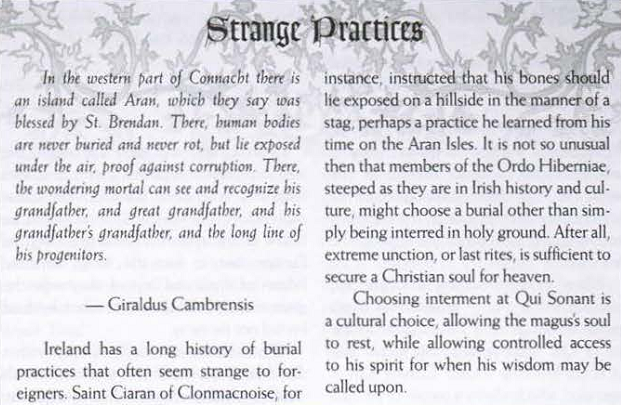
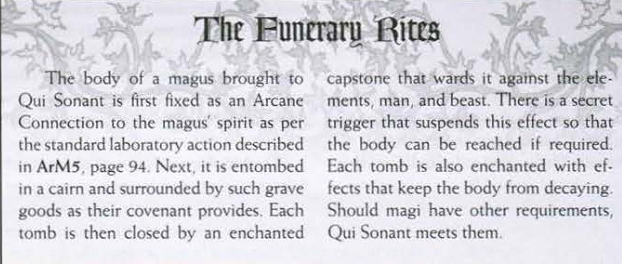
Another covenant of Ulster is Vigil, which exists to defend Ireland. Or, at least, that was the intent. It was a Diedne covenant that laid claim to its status by hunting and slaughtering the great black pig that made the ditch of Ulster, taking its tusks as trophies. The Diedne Vigil was raided in 830 by Viking runesmiths of Dublin, and when they recovered they helped defend others from the Vikings. That'd be until the Diedne, including those of Vigil, withdrew from Hermetic affairs. A band of Merinita sacked Vigil, taking the tusks north. They raised a new fortress, which they named the new covenant of Vigil, and a great invisible tower, from which all of Ireland could be seen. They used their magic to find and fight the Viking rune wizards and their warriors. Vigil also fought the vengeful Diedne, forging alliances with the fae and beasts so that, to this day, their northern coast is protected against magical invasion. Treaties still stand, declaring that no druid outside the Order has any right of traffic with the creatures of the northern seas. In the Schism War, Vigil fought the Diedne viciously, taking heads as trophies, stealing libraries and lab materials, killing familiars. In the years that followed, they used the Diedne threat to justify their importance and studied much magic. Few returned from being sent out to study, however, sending only accounts home. The last two hundred years have seen them slide into decadence and indolence, trading on a reputation centuries out of date, though the still believe themselves the defenders of Hibernia. Their cathach is the curled tusks of the black pig, six feet long. Their power tints Faerie auras, making those within want to protect Ireland, and align Magic auras to boost spells that protect Ireland. The magi of Vigil live by the rule of conspicuous consumption and they love hunting, raiding and boisterous activity. They encourage magi to marry, because it is comfortable, and to enjoy all pleasures of Hermetic life. They mock those who do not engage in such pleasures, though not very viciously.
Next time: Druids and the Coill Tri
Ireland is Druidic
Original SA post Ars Magica: The Contested IsleSo, druids. To magi outside Ireland, druid means House Diedne. It is an unpleasant, fearful word. In Ireland, Diedne and the druids were never the same - they were two very, very different traditions that are now both believed to be extinct. What is known of the original druids is mostly legend and rumor. They disappeared rather abruptly in the ninth century, but had been on the decline well before that, as they were heavily persecuted by Saint Patrick and his followers. They were lorekeepers, judges and counselors as well as pagan priests, magicians and soothsayers. All of their functions involved power over words - memories, judgements, poems. Part of the modern ignorance of druids is because they feared writing their secrets down. The word 'druid' actually denotes three sacred fucntions: bard, faith and draoi. The bard was the lorekeeper of the Irish as well as a poet. Without writing, bardic training was all about memorizing extremely detailed passages. The faith was a priest of the pagan Irish, attending to a clan's worship and divination. The draoi were counselors to the kings and lawgivers, as well as the principal magicians of a clan. All three types of druid began training with four years as a bard. Some would continue their bardic training, while others would become faith. After four years training as a faith, some would become draoi. It took twenty years, total, to become draoi.
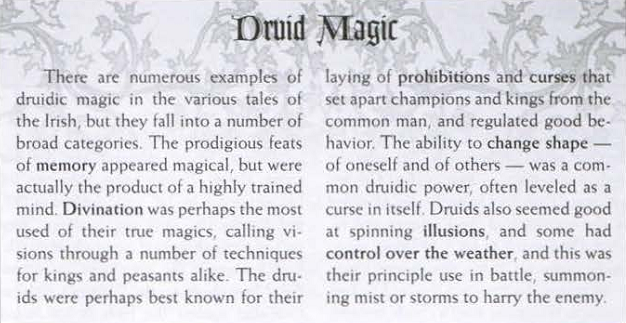
By the eighth century, druidism was on the decline due to Chrsitian assaults. The high king no longer sought advice from the draoithe and among the Christians there was no need for the faithi. Only the bardic schools survived, and their teachings were watered down by memorizing genealogy and hagiography rather than legends. In Britain and the continent, other druids suffered similarly. Celtic and Gaulish cultures all over Europe had their own equivalents of druids, which dwindled as the old pagan ways faded. However, the new Order of Hermes included a maga from a druidic lineage: Diedne, who recruited the survivors into her House. It quickly grew to be the largest in the Order, dominating the pagan priesthoods. These druids were principally Breton, like Diedne herself, but also had Gaulish and Iberian druids, as well as some more exotic types. Britain had few druids due to Roman persecution, but everyone know that Ireland was the stronghold of druidry, even if they were in retreat. Diedne decided to add them to her House.
When Diedne came to Ireland in 793, she was met by a delegation led by the chief druid, Sechnassach. She gave them a simple offer: join or die. It is written that Sechnassach was offended by her arrogance and refused. Diedne stormed off, warning of dire consequences. Sechnassach ignored the threats. When Diedne returned, she brought 27 of her magi, landing near Wexford in 797 and seperating her followers into three squads of nine, who began to hunt the druids. Each druid they met was given the same offer: join or die. Most chose death. Diedne's campaign lasted just under 15 years, and she boasted in 816 at Tribunal that there was not a single druid left in Ireland. This claim was almost certainly exaggerated, but it is without doubt that she exterminated the tradition, if not all of its practitioners. The age of the Irish druids was over.
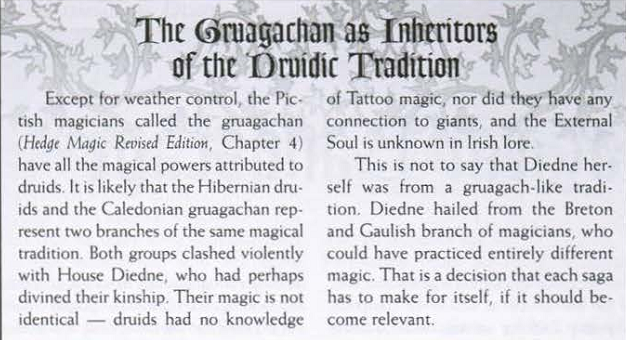
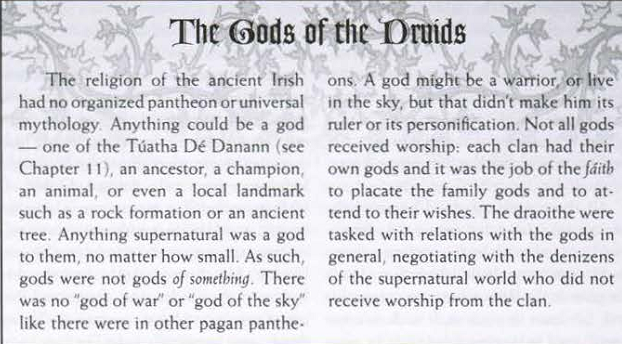
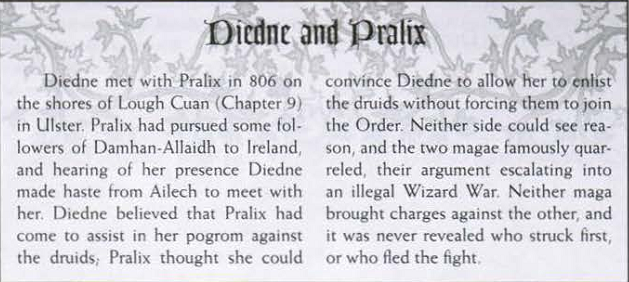
Most hedge magicians of Ireland claim descent from the druids, but this is almost certainly not true in most cases. Today, the term druid or draoi is applied to any magical practitioner with the Gift or who belongs to a hedge traditions. Other wizards are known as asarlai, hedge wizard. Many of the oaths which constitute the Hibernian Peripheral Code speciy terms 'inter druides et magos' - between druids and magi - and do not apply to asarlaithe.
The non-Hermetic wizards of Connacht are members of a federation named the Coill Tri. They are of many traditions, but all claim to be inheritors of druid lore and claim the title druid. In 844, the Chief Bard of Ireland, Cormacan the Learned, brought an embassy from the High King Congalach Cnogba to the Order. Some of the king's subjects, all hedge wizards, had complained about harassment. Fedelmid Ua Heirmeais of Mercere was appointed to act on behalf of the Order. It was already clear from Diedne's pogroms that 'join or die' didn't work here; the hedge wizards preferred to die. Since they'd sought royal protection, another solution was needed. The result of the negotiations was the Treaty of Cnoc Maol Raidh, made binding in 898 at the first Hibernian Tribunal. The Connachta wizards were incoporated into a federation originally called the Comman Cosan Chian, the alliance of the traditional way, which quickly mutated into the Coill Tri, the three hazels, after the three Cs of the group's name. In Ogham, the C is called Coll, and means hazel. The Hibernian magi encouraged wizards in conflict with magi over resources to head to Connacht, and the Order even supported them in moving, though it was not always a voluntary move. The end result concentrated the Irish hedge wizards into one province, leaving the rest of Ireland to the magi. Today, the Coill Tri claims membership about equal to the number of magi in Ireland, but perhaps much larger. There are some who try to make the Coill Tri more than it truly is, to use it as a force to mobilize the native magicians for whatever reason. These attempts usually fail, as the Gift forms a wedge of suspicion and distrust that destroys these temporary alliances. The Order's quite happy with that.
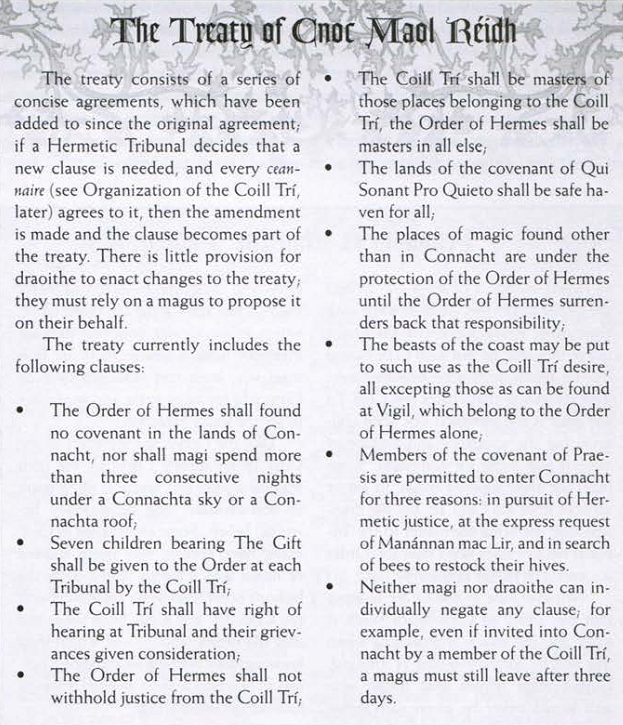
The Coill Tri is not a rival to the Order - it's just a legal entity with which treaties could be made, rather than needing hundreds of seperate treaties with each tradition or draoi. It allows the Order to have some control over the hedge wizards. The Coill Tri has no central authority or formal rules, takes no mutual actions and has no ideals held in common. However, membership is rarely optional - the Order doesn't like druids that don't join. The principle benefit of joining is freedom from molestation by magi, as per the Treaty. Every hedge wizard in Connacht is assumed to belong to the Coill Tri, and there are also some members who live elsewhere and bear an amulet of hazel leaves to prove it. A draoi wronged by a magus can complain to the Tribunal and expect investgation and justice as per the treaty. In practice, this is rarely used, and occasional breaches are perceived as less problematic than exposing yourself to the Order's scrutiny. More frequently, the Coill Tri members bring disputes with each other or magical beasts to the Sacred Council before each Tribunal, as Hermetic adjudicators ensure fair resolutions even against much stronger foes. Under the treaty, the Coill Tri must provide seven Gifted children at every Tribunal meeting. Not all draoithe can detect the Gift, and so those who offer their tithe sometimes have it rejected by the Order, which hardly improves relations. Members of the Coill Tri occasionally must be reminded of their obligation, and Redcaps go into Connacht to make demands of them.The image of a red-hatted stranger hunting for children to steal has entered the Connachta consciousness, and on occasion Redcaps must flee angry mobs.
The Coill Tri is divided geographically into seven tuatha, to make it easier to fulfill their obligation. EAch tuath must find a single Gifted child every seven years, and each is represented at Tribunal by a ceannaire, who gives each tuath its name. Some ceannairi bring complants from their membership to the Tribunal, while others require them to represent themselves. Tuatha vary greatly in organization, and the default is that they exist in name only. In some tuatha, the ceannaire is like a chieftain, enforcing rules of behavior and holding court, and local tradition affects the choosing of a ceannaire. Some are elected, others hereditary, some chosen by lot. Only four tuatha are described in the book, to leave the other three for GMs to decide.
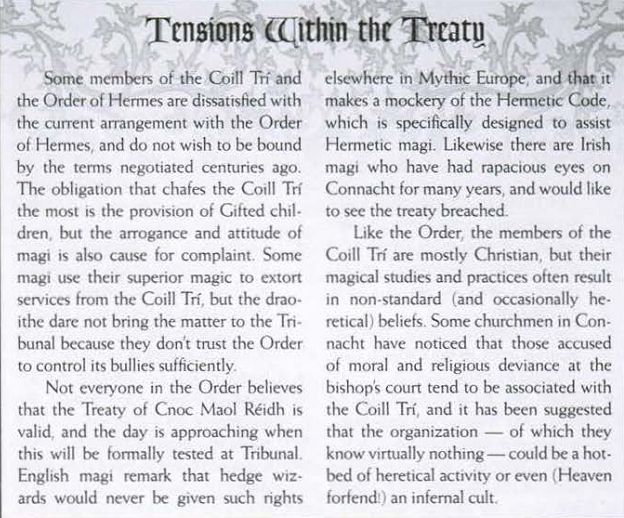
Tuath Buidhe is largely made of unGifted visionaries who seek to reconstruct old druidic lore from what fragments remain. They have a cult based on the legends of the ancients, since the true lore was very thoroughly eradicated by Christians and House Diedne. They have several ways to initiate others into magical powers, and are usually keen to bring others into the Coill Tri, even outside their tuath. They might be friendly to the Order, or bitter over the Diedne crusade still, depending on how you want to run them. Their ceannaire is always from a specific lineage of Cruithnigh wizards. Budhe is one of the Coill Tri's primary teachers and mystagogues. Widely believed mad, many still travel to his island off Connacht to gain instruction. He is often found naked in the rain, talking to trees or in trances wearing a bullskin. He has a great memory and knows how to teach many supernatural powers, some of which he has and many which he does not personally possess, and if he can be made to focus long enough, he usually agrees to teach people.
Tuath hEilionora is made of all those Coill Tri who do not leave in Connacht. It exists to permit non-Connachtach wizards to benefit from the Treaty, and for magi who live nearby a hedge tradition to treat them as a legal entity. It is twice as large as any other tuath, and its ceannaire is always the individual who takes up residence in a particular Magical area after being appointed by the last ceannaire. (The actual area in question is not named - it is left up to the GM.) The current ceannaire, Eilionra inghean Ua Shuibne, is an elementalist and a physician who firmly believes in the restoration of the druidic ways. She is a keen student of ancient tales and is halfway convinced that she is the reincarnation of Macha Mhuinge Ruadh, a former queen of Ireland and founder of the hospital at Bron Bherg. She learned her magic in France, and while she is very knowledgeable and enthusiastic about native traditions, they tend to see her as an outsider and want little to do with her. She accepts this, and is an active member of the Coill Tri.
Tuath Saidhbh has an unusually high number of Gifted wizards and always has. Its members want as little to do with each other as possible and have no common culture at all. They choose their ceannaire by lot, and no one really wants the job. Magi would dearly love to know why there are so many Gifted in their region, but are forbidden to explore Connacht by the Treaty, even if they were born there. Sadhbh Amhreaidh is the current ceannaire, and she is exactly the kind of person who sneers at Eilionora. She is a folk witch claiming descent unbroken from generations of witches. Her grandmother and herself were the only survivors of a mundane backlash against her coven, and no other coven would accept them, as their magic is somewhat non-standard for witches - they teach a rather obscure power known as Embitterment, which makes the target hostile to another target of the witch's choice. (This power is also shared by a sect of Irish Ex Miscellanea, the Nemthengacha, who claim descent from the Irish poet-demigod Bricrui mac Carbada. Or, occasionally, from Loki.) In any case, since Sadhbh has no witches to rely on and, as yet, no daughter to teach her tradition to, she is rather twisted and cold-hearted.
Tuath Ronain has recently come into shame, having discovered diabolists in their membership. Worse still, it was found by a magus, so there was no chance to deal with them in secret. The tuath is now vigilant against any further corruption, and their ceannaire recently appointed three inquisitors to watch the tuath. They are paranoid now, and very mistrustful of each other, especially their Gifted members. The cennaire Ronan Brathair is a Cistercian monk as well as a draoi and was instrumental in rooting out the diabolists. He uses holy powers via meditation, and would like to turn the Coill Tri closer to Christian worship, but is humble enough to realize that's a truly immense task.
Next time: Bards.
Ireland is Music
Original SA post Ars Magica: The Contested IsleThe bards, unlike the faithi and draoithe, managed to survive. The Christians saw them as mere poets, and the Diedne as just petty magicians, and so they are virtually unchanged. They preserve the old legends and the Christian homilies, and they compose new works for their royal patrons. Today, they call themselves filidh, to distance themsevles from their druidic origins. Bardic study is divided into nine grades. The first four years are basic education - grammar, composition, history, genealogy, geography and society. Bardic schools fulfill the job grammar schools do elsewhere in Europe, educating the sons of the aristocracy. Any pupile that passes the (rather difficult) test at the end of four years can claim the title 'fili'. Bards who remain at the school continue to learn the tales and expand their memories massively. A senior bard is expected to know at least 200 stories and can compose poems layered with interpretation. Thge highest rank, Ollamh, takes twelve years of continuous study, and only an ollamh can found their own school. The ard-ollamh Erenn, the chief bard of Ireland, is not just the personal bard of the high king, but also the king of the bards. Only one whose father and grandfather were also bards can become the chief bard, and they mediate disputes between bards and non-bards as well as setting the fashion for poems and prose. Only the chief bard can strip a bard of their rank. The last chief bard was Giolla Ernain Ua Martain, who died in 1218, and a successor has not been chosen.
Bards are extremely respected, a respect that dates back to the druids. While the ocncept of bardic immunity, once guaranteed by the high king, is gone now, a bard's reputation still carries a lot of weight. A bard can expect basic hospitality from the Irish, and it was long forbidden to start feuds with bards. Even bandits and thieves fear attakcing or stealing from bards, so they can walk the roads in relative safety just by their reputation. There are several bardic schools, but four are more notable than others. The most famous bardic family, of course, is the Ui Dalaigh school of Dromnea. Most chief bards of the past 600 years have been Dalaigh, and the school was founded by Cearbhall Fionn mac Aonghus Ua Dalaigh after he received the gift of poetry from the milk of a faerie cow. The famous Cu Connacht Ua Dalaigh was celebrated as the finest of bards in all Ireland, alive or dead, and was the great grandfather of the current family had, Donnchadh Mor Ua Dalaigh. The school is in Dromnea, on the Mhuintir Bhaire peninsula of Connacht, which the Ua Dalaighs rule as chieftains.
Second is the Ui hEodhasa school, Baile Ui Eodhasa, on the shores of the Lough Erne in Ulster. They're famous for their epic poetry, focusing on grand battles and heroic slaughters. Such dramatic poems are no longer in fashion, so the Baile Ui Eodhasa are now rather weak and struggling to find patrons. Third are the Ui hUighinns of Ceall Cluaine, better known as Kilcloney in Leinster. They are the smallest of the four great schools, and famous for their intricate and beautiful tales that layer meaning after meaning on the story structure. They are also the greatest producers of magical stories, and the only bardic school that teaches music, though they do not hold it to the same bardic standards as prose and poetry. Last are the Mac Craiths, the hereditary poets of the U Briains. They are Munster bards, based out of Cahir Castle near Waterford, and perhaps the most politically obvious of the bardic schools. (The Ui Dalaigh are just as active, but much more subtle.)
You can, obviously, play a bard. Bards are protected by reputation and tradition, and are often able to mesmerize and invoke emotion with their stories and poems. They are rarely musicians, officially, though many do learn music. Still, combining music with bardic tales is a great sin in the eyes of tradition. They have extremely good memories. Some bards are magical, as well, using the ancient power of the old druidic bards, though not all can attain such power and no bard will admit it exists. Some bards of power are Maistirs, the Irish variant of the Maestro, and many of those along with some non-Maistir bards are Wordsmiths, particularly among the Ui HUiginn, who can even sometimes create more complex Craft Magic stories, like the Rusticani of Ex Miscellanea.
A Wordsmith is a bard who has the power to compose magical poems. These enchantments are made like normal magic items, save that they are not crafted by hand, but by mouth. Unlike most wondrous crafters, a wordsmith can create magical effects of any Art, but are instead limited in other ways. They gain only half the normal bonuses from shape and material of items that form a major part of the story or poem, and more importantly are limited in effect: they can only create personal-range, performance-duration, sound-target spells. Like other wondrous items, a wondrous tale can only be used by the person for whom it was made, and no one else - they just get words. When the intended user activates the magic by reciting the tale, it forms an Arcane Connection to them in the form of their speech.
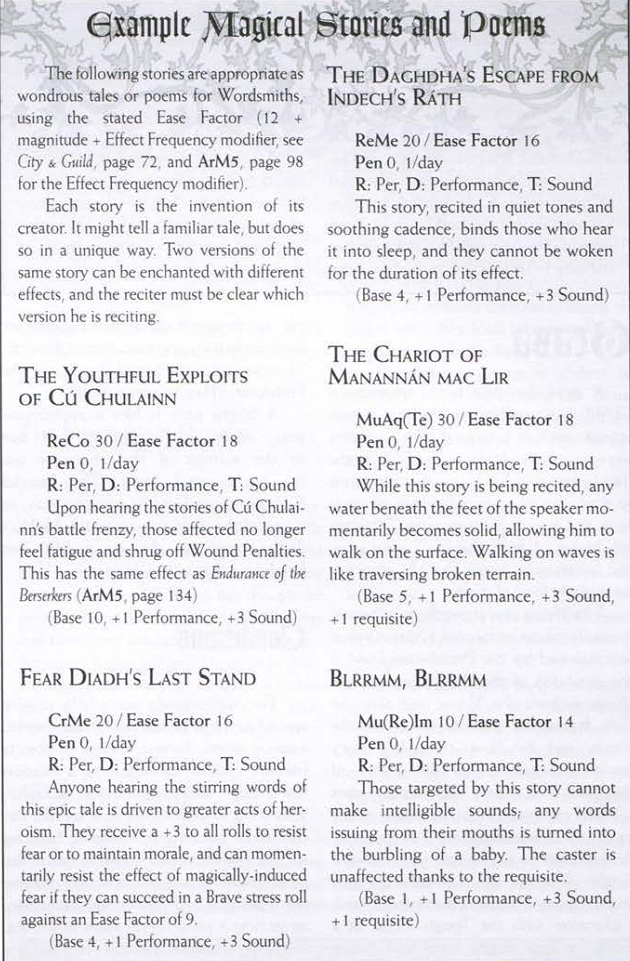
Now, let's talk about geasa. A geas is an enchantment in which certain actions result in magical punishment. They were one of the great tools of the druids, applied to kings and champions to mark them as great heroes, and applied to enemies as curses. A fortifying geas strengthens its bearer, generally providing a minor Virtue along with a prohibition Flaw. If the Flaw's condition is broken, both Virtue and Flaw vanish, though it may be possible to perform a quest to regain them from whoever originally granted them. Often, such a Virtue has a minor supernatural manifestation - if you are blessed with skill in arms, your weapons might hum as you wield them, while a blessing of toughness might make you grow horny, thick skin. A prohibition geas is just the flaw, with no benefit. If you break the stricture, you lose the prohibition but gain a new flaw, either a permanent minor one or a temporary major one that can be removed via questing or time. Such a major flaw, if lost, restores the prohibition when it goes away. A blight geas is like a prohibition geas, but the cause is external rather than the character. Most famous among blight geasa is the ces noidhen, or Macha's Birth Pangs, which curses all trueborn, pureblooded male Erainn. When their homes - village, parish or province - are threatened, they are afflicted with the pains of childbirth for five days and four nights. This pain is statistically represented as a Medoim wound, which can worsen as normal and is treated as normal in all ways, save for two. First: you can't die of it. Second: medicine and chirurgy cannot heal the wound, for its pain is entirely phantasmal.
The conditions of a geas usually involve a type of person or creature (such as priests, otters, women or horses), a class of objects (swords, crowns or cabbages) or a location (by a ditch, under a roof, in Connacht). This thing is then linked to a circumstance, such as wearing, eating or harming it. The final part is the injunction. Prohibition geasa typically use 'never': Never harm a woman, never help a priest, never swim in the sea. Fortifying geasa can use 'never' but typically use 'always': Always help a woman in need, always wear a beard, always sleep alone. Blight geasa typically use 'while' or 'if.' While you are alone, while you are on the sea, if Ulster is in need.
So, how about non-humans? The Fomorach were never met by the first invaders of Ireland, the people of Cessair, but have always claimed to be the aboriginal people of Ireland. They have a strong tie to the sea, to darkness and to winter, so they easily survived the Flood and fought all later invaders, until their power was broken at the second battle of Magh Tuireadh. They retreated to the islands north of Ireland, where they still dwell. The elders of the Fomorach were the children of the goddess Domnu, who was a ruler of abyssal darkness. These mythical kings - Balor of the Evil Eye, Cichol the Footless and Indech, to name a few - still exist as kosmokrators, immense spirits able to manifest vast elemental forms. They were defeated by the faerie gods of the Tuatha De Danann at the battle of Magh Tuireadh, and ever since they have withdrawn their aspects from the world and play no parti n mortal affairs. Today's fomorach are greatly diminished in power, and locked into horribly deformed bodies of immense size. Most have given up their predatory ways, though some are still pirates of less-used shipping routes. Their kingdom, of course, is Tir Ghomoraig, north of Ulster.
Fomoir, stastically, are Magic Humans. All of them are at least ten feet tall, and many larger than that. All of them are obviously deformed, though no two are exactly alike. Cichol the Footless had the lower body of a snake, Lot had four eyes on her back and a bloated mouth on her chest, and her husband Goll had no eyes on his face at all. Human descendants of a famoir may display similar deformities when they enter their battle-rage. Fomorach are associated with water, and often have powers related to the oceanic abyss. All of them are cursed to weaken and not heal when they set fot on Irish soil, and all of them possess the power to breathe and function normally underwater with no penalties whatsoever.
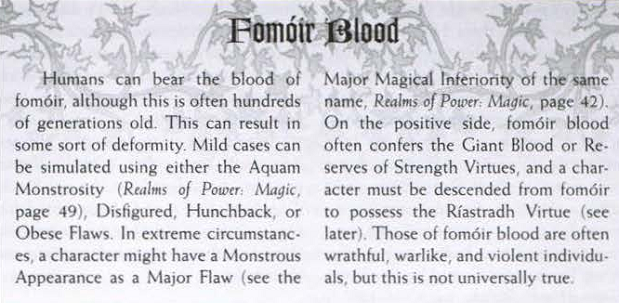
Now, the Fir Bolg. They came after the flood that destroyed the Nemedians, as three tribes: Fir Bolg, Fir Domhnann and Gaileoin, though the Fir Bolg were most numerous and so gave their name to the race. They landed in the southern part of Ireland but soon spread through the land and were the ones to create the provinces, with the exception of Meath. As they spread north, they found Fomorach cities. Initially, they fought, but peace was gained via Fir Bolg tribute, and they became a slave race to the Fomorach, growing food for their masters. When the Tuatha De Danann came, the balance shifted. The Fir Bolg were given the choice of one province to retire to once they were defeated; they took Connacht. When the Fomorach came looking for their tribute, the Fir Bolg were gone and the Tuatha De were ready to fight. The Fir Bolg are now rare in Connacht and dwell primarily on the isles of Aran. It is said that the Fir Bolg were once human, but moreso - taller, stronger, handsomer and more skilled. They were peaceful, expert farmers with power over fertility. However, the Fomorach bred with them, and today, few Fir Bolg have escaped the deformities of their mixed blood. Only the royalty are free of it.
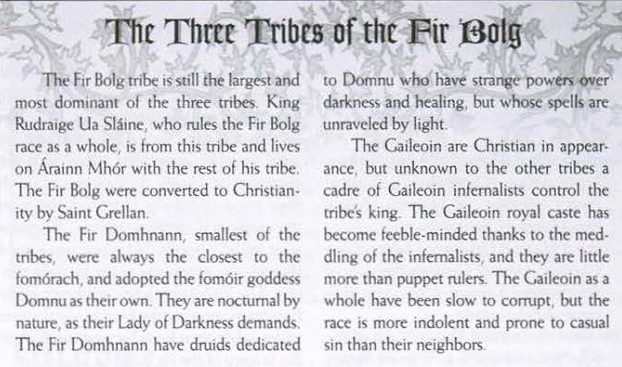
Fir Bolg are statistically humans with Magical Blood. Most of them have a superhuman attribute and are around six to eight feet tall. Unless they have royal blood, they also suffer the deformities of the Fomoir, and while originally peaceful, their monstrous blood has made them wrathful and bloodthirsty, often suffering the Riastradh. Royal firbolg often retain some powers of healing or fertility.
So - what's the Riastradh? Ancient Irish heroes were famous for it, the battle transformation, along with the clesa. This transformation is due to descent from the Fomorach, either directly or via the Fir Bolg. Any amount of Fomoir blood is enough to have the possibility of the Riastradh, and it is also possible to have a lesser form by taking the Berserk virtue. The Riastradh is most famously a trait of the hero Cu Chulainn, who inherited it from his half-Fomoir father, Lugh. The Riastradh is a major part of anyone who has it, who always suffers either violent fury or at least wrathful nature. It is an involuntary shift to a fomoir form that occurs when you get angry. Any time you might get angry, you can either let it happen or try to resist it, though you must roll to resist each round that your anger's stimulus is still there. Pain is the most common stimulus. The Riastradh changes your skin color, bulges your muscles obscenely and may cause bones or bone spikes to pop out of your skin. Each one is unique, and you get three fomoir powers free. You can get more by taking fomour weaknesses, one for one.
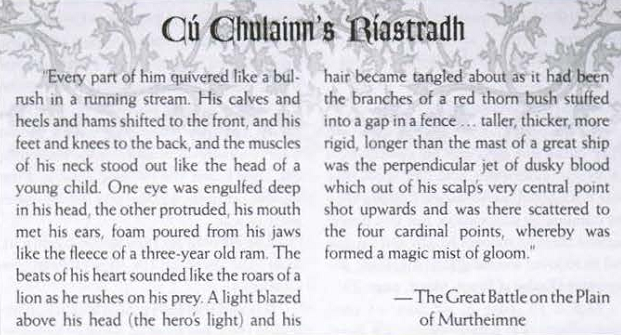
Powers include two different levels of 'being huge', which can stack together, improved ability to soak damage, improved combat initiative with a single type of weapon, which can stack with itself, and improved skill with a single type of weapon, which can also stack with itself. Weaknesses include deafness, an appearance so horrible that you cannot even begin to interact socially - not even to lead men in battle, a bloodlust that takes you for as long as the Riastradh lasts and forces you to keep attacking innocents and friends when you run out of enemies, or a reduced ability to defend yourself. If you change size, your armor falls off when you transform. Your are immune to penalties from fatigue while transformed, but still suffer Fatigue - you just ignore it until you fall unconscious. Becoming unconscious is the sole way to end the Riastradh, though you can speed it along by deliberately exerting yourself.
Next time: Magical Beasts.
Ireland is Glimmery
Original SA post Ars Magica: The Contested IsleBesides the riastradh, there is another new magic power introduces: the luan laith, or hero's light. This is a physical projection of light from your forehead, fairly common amonger Irish berserkers or sufferers of the Riastradh, though not exclusive to them. You can will the light to appear easily, and it often spontaneously appears in times of stress. If you act in a cowardly way, it will fade and flicker. The light can be seen by all even on the brightest dear, making allies braver and enemies fearful. If you are fighting on your own alongside allies, than any allied group gets +3 to any Brave or Morale checks they have to make, while enemy groups get -3 to them. This has no effect on characters fighting solo on your side, though they're sure to notice it. A similar power is the sian cuarad, the hero's war cry, which is essentially identical, save that it is an unnerving sound rather than a bright light.
So, let's talk about the magical beasts unique to Ireland. Occasionally, the seventh filly born to a mare with intervening colts is born a true mair, a fiorlair. No evil force can interfere with a fiorlair or anyone riding it. They are the fastest of horses, and any magus or lord would love to own one, but all attempts to deliberately breed them so far have failed. Enslaving a fiorlair with magic will certainly raise a complaint from the King of Eagles, so they must be befriended instead. At the very spot where a true mare touches the ground when born, a plant will grow: the seamair Mhuire, Mary's Clover, a four-leaf shamrock that can be turned into a protective talisman. It must be plated in silver, then blessed by a priest, then have prayers to the Blessed Virgin sung over it every day for a full season. After that, it will give its bearer great luck.
The dobhar-chu, or king otter, is a gigantic otter with pure white fur, save for its black ears and the black cross on its back. Its hide cannot be pierced by any metal save silver, and anyone hwo kills a king otter will suffer its death curse, and probably die within a day. The dobhar-chu are highly aggressive, similar to lions or leopards in ferocity, and usually travel in aoirs. One will hide while the other fights, and come out if it seems the first will be defeated. The skin that bears the black cross is legendary for its protective powers - it can be made to bless a boat against sinking, a house against fire or a person against accident. However, this can only be done by the killer of the king otter, who must survive the death curse. The skin must be cured, either in salt (for a boat), smoke (for a house) or sweat (for a person). The curing must be done once a day for a full season, and each day the hide must be rubbed 729 times - that is nine times nine times nine. Once the season ends, the skin will either grant an immunity to all water-based harm to a boat, fire-based harm to a house or immense luck to a person. Note that the boat and house are protected, but not necessarily the people on or in them. The death curse of a dobhar-chu takes the form of a single moment of extreme back luck - a lightning strike or collapsing bridge, say - which will likely be fatal if the victim is not either very lucky or very skilled.
So, on to the faeries. Faeries are common in Ireland, and everyone has at least had some interaction with them. Perhaps a peasant spots faeries from afar, or a king ritually marries a faerie. Their homes are common, and they can be quite dangerous. To avoid their anger, the word 'faerie' is avoided. They are known as daoine matithe, good neighbors, daine sidhe, people of the mound, croc na gcnoc, the host of the hills, or even just iad, them. Because of their reputation, most people can easily recognize faeries. Several resemble humans, though better dressed and more handsome, while others are animal shaped, such as the Salmon of Wisdom or the two bitches of Fionn mac Cumhaill, while others are monstrous hybrids. The Otherworld of the Irish faeries is known by many names - Tir na nOg, the Land of the Young, Tir na mBeo, the Land of the Living and Mag Mell, the Delightful Plain. Hermetics are unsure if the different names are different places or the same one. Tir Tairngaire, the Land of Promise, refers to an immense Faerie regio overlaying the sea around Ireland, which is said to be only enterable via the Isle of Man, where a supernatural tree grow, supported by four legs of silver that rest on the ocean floor and from which grow golden appels. No one knows if Tir Tairngire connects to Tir na nOg or not. Magi do know these names refer in some way to the worlds of Faerie that have generally been categorized. About half of the Irish fae live in Elysium, the land of recorded myth, while a third live in Eudokia, the land of personal growth and story. Eudokain fae include baby thieves, wife-stealer and drunk-misleaders. Arcadia is home to the fewest of the Irish fae, though it's a growing population. The most common faerie home is a mound, or sidhe, which is a word also used for the fae themselves. The interior varies wildly by its inhabitants, from a rude cave to a grand mansion. Cairns and tumuli also house the fae, along with mountain peaks, lake bottoms, forest hearts and marshlands.
Now, it is known that on the night that Conn of the Hundred Battles was born, five roads were found leading to the royal fort at Tara. Thse High Roads reach to all parts of Ireland. They are named slighe, and are wide enough for two wagons to travel side by side. The other roads of Ireland are not so reliable as the slighe. Each of them has a Faerie aura, and is a trod, a liminal space between places. Each road ends in two places - one end at Tara and one elsewhere. At each of the endpoints, the Guardian of the Road can be called forth. When evoked, the Guardian will seem to appear, but in truth the summoner is transported into Faerie by the Guardian, who might then be persuaded to allow travel on the road, generally by defeating its challenge or appeasing it. Those who travel the road can thus use Faerie to reach their destination. They appear to spend the same time travelling as they would in the mundane world, but on reaching their destination they will find they moved at twenty four times the normal speed, taking less than half an hour to complete a day's travel. The destination may be any point along the Guardian's road. Some know how to cross into Faerie on points along the road other than the endpoints, but must do so without the aid of the Guardian.
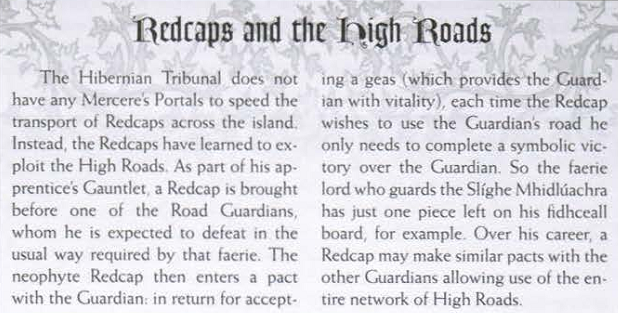
Slighe Assail travels west from Tara, towards Lough Owel, then on to Rathcrogan. Its Guardian is a middle-aged woman with a crooked staff, whom some magi claim resembles Pralix. Her challenge is a debate on some esoteric subject, which is won not by knowledge but by clever answers. Sligh Chualann runs through Dublin, on past the Wicklow Mountains, then south along the River Barrow to Waterford. Its Guardian is Oisin, son of Fionn mac Cumhaill, who rides the faerie horse Embarr. To pass his challenge, Oisin must somehow be made to dismount, at which point his faerie youth evaporates, leaving him old and withered. Sligh Dhala heads southeast to the Littey, then southwest along the Bog of Allen to Limerick, then ends at the mouth of the Shannon. Its Guardian is a Black Dog, a faerie embodiment of fear. To defeat the Black Dog, it must be dominated, and the terror overcome. An tSlighe Mor runs south, then follows the Eiscir Raidha between Dublin Bay and Galway Bay, passing through Durrow and Clonmagnoise. Its Guardian is Gamal mac Figal of the Tuathe De Danann, a doorkeeper who demands that you prove your uniqueness in a chosen skill. Slighe Mhidluachra, the final High Road, leads north to Eamhain Mhacha via the foothills of the Mournes, then along the east and north shores of Lough Neagh, ending in Derry. Its Guardian is a faerie lord who demands a game of fidhceall - chess, basically. Those who lose tend to find themselves in bad places.
There are four types of Irish fae. Strongest and rarest are the pagan gods. The legendary heroes of the past are social faeries, reenacting their old adventures. Trooping faeries are those who roam the countryside as gangs, causing destruction. Solitary faeries are unattached to a group, generally linked to some terrain feature. Each obeys a set of traditions and roles, and what is true of one may not be true of another. The pagan gods, the Tuatha De Danann (which means 'Children of Danu') were originally faeries attached to the powerful elemental spirit of the Danube. They were found by a Nemedian descendant's tribe after fleeing Ireland, and relocated to four mysterious cities before returning there, invading the Fir Bolg and Fomorach. For 200 years, they ruled and interbred with their motal followers, but were eventually defeated by the Milesians and left for the underground. While rarely found, there are many of them, mostly kings, warriors and leaders. They are all well-formed and handsome nobles. They are not quite gods in the traditional sense - they have interests, but no specific portfolios or areas of control. They were not truly worshipped, but lived with and learned from, and many still remember and revere them without worshipping them.
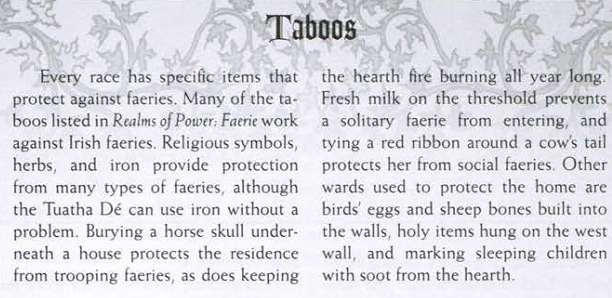
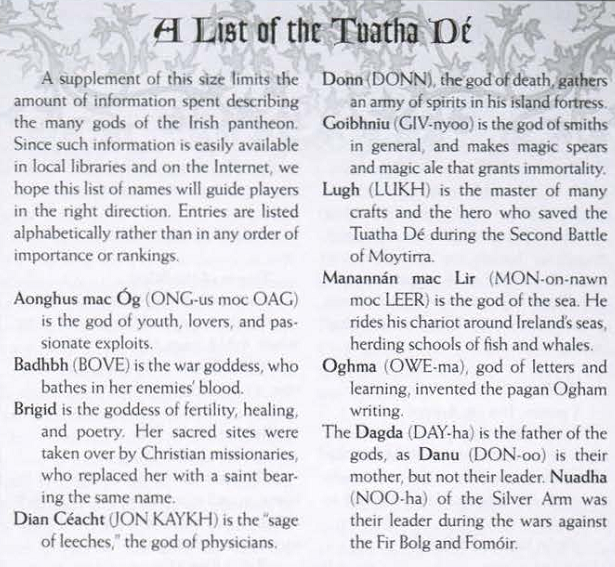
Social faeries are those that seek interaction with humans the most. They are also called hero-faeries, for they are frequently heroes. They are more prone to peaceful interaction than others, though some can be very dangerous. The most common type mimics famous heroes, often from the Ulster or Fenian Cycles, but any character from the hundreds of folk tales and legends could show up, even a saint or demon. Some have so many tales about them that magi suspect several faeries of adopting different aspects, and so magi refer to them by longer names. Cu Chulainn Slaying Connla, for example, is the Cu Chulainn who kills his son, while Cu Chulainn Stealing Emer is a different faerie that abducts his wife, and Cu Chulainn Killing Cu Roi is the one that kills the faerie king of Munster. Others disagree, though, saying that there is only one very powerful Cu Chulainn, perhaps the most potent faerie in Ireland. The truth is uncertain.
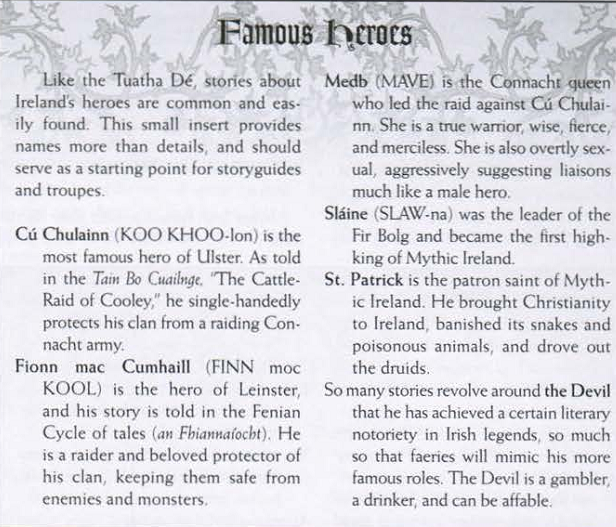
Trooping faeries, also called slua si, are roving gangs that wander the night, killing and destroying. It's hard to say what they emulate, as they've played the role for so long that they're basically a story unto themselves now. Some might have started out mimicking pagan warbands like the fianna or the Ostmen, while others might be copying English knights. Some of them look like ghostly replicas of modern soldiers, while others are primavel, hunched and hooded men. Still others are flying phantoms, thought to be the restless dead, though they have no connection to either the Infernal or Divine realms.
Solitary faeries are a catchall for faeries that work alone. Sometimes a small band of them might work together, but only if they're unconnected to a larger group. An old crone that lives in the wood, the three-headed giant that ravages Tara and the sea monster of Lough Derg are all examples. They are often just as bad as trooping faeries, following regular patterns of destruction in legend.
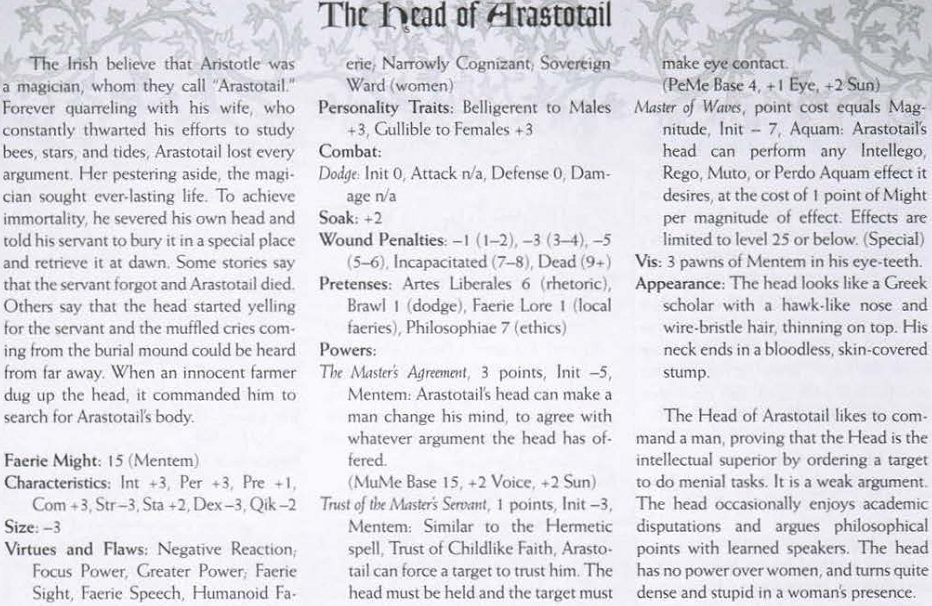
Now, let's talk about the Divine. In western Europe there is only one Church, led by the Pope. The Irish accept the Pope's authority, but a strange situation has arisen, and in 1220 everyone accepts that there are now two Churches in Ireland - two factions of the greater church, one based on native tradition and one looking to the English throne and Church. They are conflicting over discipline and organization. Complicating this is the divide in the Irish native Church between reformers and traditionalists. The dioceses of IReland came later than in Ireland and are still at times contentious. By last century, they were imposed by reformers, but the relations of the new bishops and the old abbots who head the ancient comarha are still troubled. Most traditionalists look to the comarha, not the bishops, for leadership.

Next time: Christianity in Ireland
Ireland is Churchy
Original SA post Ars Magica: The Contested IsleThe Irish Church is rather unique. It is fiercely loyal to the Pope, of course, and frequently sends letters to Rome about rleigious practice, but some within it feel it desperately needs reform, and as of last century, they got organized. Synods were held, discipline was debated and the reformers, mostly bishops, have done much to bring Ireland back in line with the rest of the Church. A traditionalist faction largely made of abbots and old monasteries has resisted the chance. They debate not doctrine and theology - everyone's in rough agreement there - but on custom and organization. The Irish Church is built on agreements, charters, deals and unique cases, not the complex hierarchies of most of Europe. If an ancient saint gave a right to demons or faeries, that right must be enforced. The Irish Church is not nationalist and is barely unified on anything.
The traditional organization of the Irish Church is based on the paruchia - not a parish, but a number of monastery that owe allegiance to a shared founders' monastery, similar to the vassal-liege relations of Normandy. These monasteries and parishes may be and often are geographically distant, but they make up the paruchia, which is ruled over by a comarba, an abbot in the line of one of the saintly founders. The paruchia of Saint Columba, for example, is a bunch of monasteries under the spiritual leadership of the main abbey, whose abbot is known as the comarba Colum Cille. The reformers attacked this system in the 11th and 12th centuries, replacing the paruchia with dioceses, and the comarba's influence is now largely limited to loyal monasteries. The tension between the comarba and the reformer bishops remains, but for the last 50 years, most of Ireland has been behind the bishops.
Confession is not much different in Ireland than most places. Irish writers have written a lot on penances, and they are highly respected for their work in the field. Irish traditionalists may have condemned the practice of absolving the same sin more than once, but they've always been sympathetic to private confessions, and may in fact have influenced the entire Church with their belief in private penance, between priest and sinner and no other. Breaking the seal of confession is so heinous to the Irish that it is one of the four unforgivable sins. In Ireland, per the rule of Saint Maelruain of Tallaght, there are four things for which no penance can be done, you see. Firstly, breaking the seal of confession. Second, necrophilia. Third, incest. Fourth, being a sinner priest. God alone can forgive these sins, and no other. The Irish find anyone guilty of these sins to be considered excommunicate, denied the sacrament and often driven into exile. The traditionalists of the Church also refuse second chances - if your sin has been forgiven and had penance done, and then you go and repeat it, that may well be considered unforgivable, a hardline approach rarely seen elsewhere. Many reformers are more sympathetic to sincere repeat sinners, and may offer forgiveness along with very steep penances, and some reformers allow tha a priest or bishop might be forgiven venal sins, though never mortal ones. The English Church is typically more pragmatic about penances and find the Irish approach to be theologically suspect, though they agree that any priest committing a mortal sin should be taken to court and probably defrocked and heavily punished. Monks who shed blood or engage in mortal sin can be forgiven, but will usually be exiled as a penance. (This actually happened to Saint Columba.)
Now, let's talk about saints. Alongside Patrick, there's over a hundred saints popularly venerated in Ireland, and many Irish saints went abroad and are beloved in foreign lands, too. Patrick (or Patraig) is the patron saint of Ireland, though British-born, and is exceptionally powerful. He most famously drove the snakes and venomous things from Ireland forever. Any Irishman can call on Saint Patrick and at least hope for a response. Brigid of Kildaire, or Naomh Brid, was the child of a nobleman, but her mother was sold to a magician when it became clear that the woman, who was a concubine, was pregnant. The child was so holy that when she was born she would not eat the magician's food, but lived off milk from the cows. She swore to remain virginal her entire life, and she took vows as a nun, though some say that the blind bishop that swore her in mistaknely consecrated her as a bishop instead. As he did so, his sight was miraculously restored. Brigid traveled throughout Ireland, healing the seak and helping the poor in her chariot. She did many miracles, and had a special love for the poor. Saint Columba, or Colum Cille, was one of the twelve apostles of Ireland, founder of several monasteries and famous for arguing with Saint Finian of Movilla over a book Columba copied but was not allowed to keep. The argument escalated, leading to the Battle of Cuil Dreimhne, where many died. Columba was exiled, heading to Scotland to preach to the Picts and eventually banishing the Loch Ness monster and performing many miracles. He converted many of the Picts and Gaels of Scotland, and despite his exile from Ireland he is considered one of the three great patron saints of the island.
Saint Abban is unusual for an Irish saint because he was converted before Patrick came. He traveled in England and founded a monastery at Abingdon, you see. He was borna Leinster prince, but went to Rome to see the Pope, and on the journey performed miracles including the banishment of a sea monster, and on his return he defeated another monster. He is revered for he;ping convert the English and is quite popular with Irish priests resisting the English. The Bishop of Ferns, Ailbe Ua Mail Mhuadh, wrote a hagiography two years ago and is encouraging devotion to Abban. Saint Grellan is interesting because he lived in a time in which the Fir Bolg were at war with the tribe of Colla de Chrioch. The Fir Bolg used a false truce to take the king's son hostage, then murdered him after he seduced their queen. A second truce was arranged, but the Fir Bolg again planned treachery. As they drew their weapons, Grellan saw them from his church and prayed to God. The Fir Bolg sank beneath the earth, where some sway they are still trapped below the bog of Mach Liach, while others say they were sent straight to Hell.
Irish saints are noted for having rather unusual miracles - often ones that draw on nature, or which curse enemies. They have been known to banish monsters, bless books, call the waves to harm foes, hide fugitives, bless wild animals to keep hunters away from them, shatter false idols, curse ships with still winds and waters, free prisoners, make fires unquenchable and everburning, curse people to be unable to lie or bless people to walk on water.
In Ireland, there is a holy tradition known as the Celi De, or Culdee to the English. They are not a monastery, but a tradition of ascetic monks and laymen who follow the Rule of Saint Maelruain of Tallaght. Many are miracle workers as well as scribes and scholars. While some are laymen and take wives, they still practice asceticism and observe the litrugical hours. They study Invocation, Intervention, Purity and Transcendence. They spend parts of the year in monasteries and parts living as hermits, returning home only for saints' days and communal rites. Many have been abosbred over the last century into regular priestly orders, but others have chosen to live secularly and do not take vows of celibacy. Celi De are never, ever wealthy due to their vows of devotion taking so much time. The Celi De are often members of the Coill Tri, especially in Tuath Ronain. They fast a lot and often pray with arms outstretched as if nailed to a cross, though they never perform self-flagellation or punishment on themselves - if they ever need it, they get another to administer it, but even that is uncommon. Celi De often confess to each other rather than priests. The Irish Church sympathizes with them, but often the reform faction prefers to reorganize their monasteries, and the English see them as unorthodox and suspicious. Very few Celi De remain in Leinster or Munseter, but on the islands in the north, they can still be found.
So, demons. Demons have been in Ireland since the days of Partholon. When his wife, Delgnat, had an adulterous affair with the servant Topa, a demon revealed the crime by giving Partholon the power to taste their betrayal on a cup they had shared. PArtholon killed Topa, and thus the sins of adultery and jealousy came to Ireland. Second came plague. Partholon was first to die, but his people followed after. Only Tuan, nephew of Partholon, survived. He took the shape of animals to bring warnings of plague to later generations. War is the third of the Infernal weapons in Ireland. When Nemed came, he brought war with him. He defeated the Fomorach kings at Ros Fraechain, Badbgna, Cnamros and Murbolg, but each victory had a price. His wife died of plague twelve days after arrival, and he lost sons in two of the battles. And then, again, the Infernal plague came and killed Nemed, allowing the Fomorach to enact revenge, enslaving the Nemedians for 207 years before they could rebel. Even then, Infernal luck followed, for as they fled by sea, the Fomorach raised a deluge to sslaughter all but thirty men who fled in a single boat. The Infernal in Ireland promotes suffering however it can - giving a king luck in battle but taking his son in the same day, perhaps, or helping a people kill themselves.
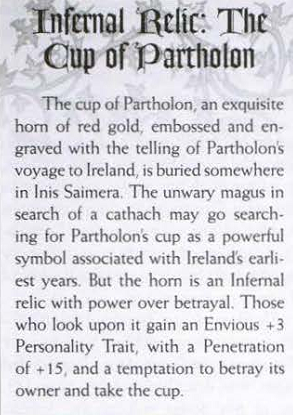
Typically, Hibernian demons have two main approaches to encouragin sin. First, they give a man such hardship that he has no choice but to turn to evil. Second, they catch his interest and then stoke it via envy and obsession until he damns himself. Well, that and plague, of course. Plague leads to closed doors and abandonment of charity, so the Infernal spreads disease and famine in order to force people to extremes. Sometimes, the illness is restricted, sometimes not. Sometimes they leave careful exceptions - small islands of plenty in a sea of misery - to encourage envy and greed. In such times, it is wise to find the source of the illness and famine and end it decisively before the envy and desperation reaches a tipping point and leads to theft and raids. Fortunately, the Order is not alone in fighting demonic plagues. The Church does its best, though it is not always capable...and the druidic traditions also help, especially in Connacht. Folk witches treat the sick, Nightwalkers fight the demonic spirits, the few Elementalists of Ireland use their powers to fight the cold or heal the diseased. Others in the Coill Tri can ward against plague or banish illness.
The demons of Ireland have thus learned to be subtle. They do this not from intelligence, but malicious cunning and cowardice. Any creature that claims to be a servant of Hell probably isn't one. All Hibernian demons can, like any demon, take physical form...but because of Saint Patrick, none of them may adopt serpentine shapes, and any demon who can only take serpent form can never materialize in Ireland. Demons of Ireland prefer temptation to anything else, encouraging obsession and sin, occasionally possessing victims to persuade others to sin by lies and subtle trickery. Demons of Ireland are known to be able to bring plague and winter chills, as well as to kill those whom they send nightmares to. The isle is also home to the Sluagh, invisible spirits that can smell death coming and flock to it. They are compelled to fly to the dying from the west, and may enter homes only via windows. For this reason, it is wise, if little-known that one should shut western windows around the sick, wounded or old. The slaugh come only by night, keening as they fly but falling silent on arrival. They climb through windows and watch, clacking their teeth, or they knock on closed windows. Once inside, they steal their victim's last breath, and their spirit with it, which they drag away and scourge until it, too, becomes a cursed Sluagh. If they cannot get in before the victim dies or receives last rites, then they have no power over that soul.
It is said that a candle left burning in a field overnight will protect cattle from demons. A hagstone - that is, a small stone with a hole in it - hung in a stable keeps demons from stealing hoses, and over a child's bed, it protects against demonic child theft. It can also block the dark dreams sent by demons. Some demons, like the Sluagh, can only enter via specific directions and only vy open doors or windows. A branch of elderwood can bind a demon in place for a night, as it must obey its obsessive nature and count each thorn and berry on the branch until morning, when sunlight drives it away. Wearing a pouch of salt protects against demonic posession, if the pouch was well-made, too. Faeries who take on the shape of demons also must obey these weaknesses.
Some battlefields are terrible, Infernal places. For example, Magh Slecht, home to a giant standing stone in the form of the god Crom Cruach. Before Patrick came, it was ap lace of human sacrifice to ensure good winters and harvests. It was the only place in all Ireland that this was done. It has always been home to demons, and after Patrick banished the demonic Crom Cruach underground, the sacrifices ended. The tragedies did not. The druids of the Masraige who survived atrick's battle were ultimately killed by Diedne. The ?Ui Raghallaigh clan used the field to war on their neighbors and even Hermetic blood was spilled there in the Schism War. EVen now, it is a strategically important place. History records that the Ui Raighallaigh will again fight the Ua Ruairc here, in 1256, which will divide Breifne into two kingdoms.
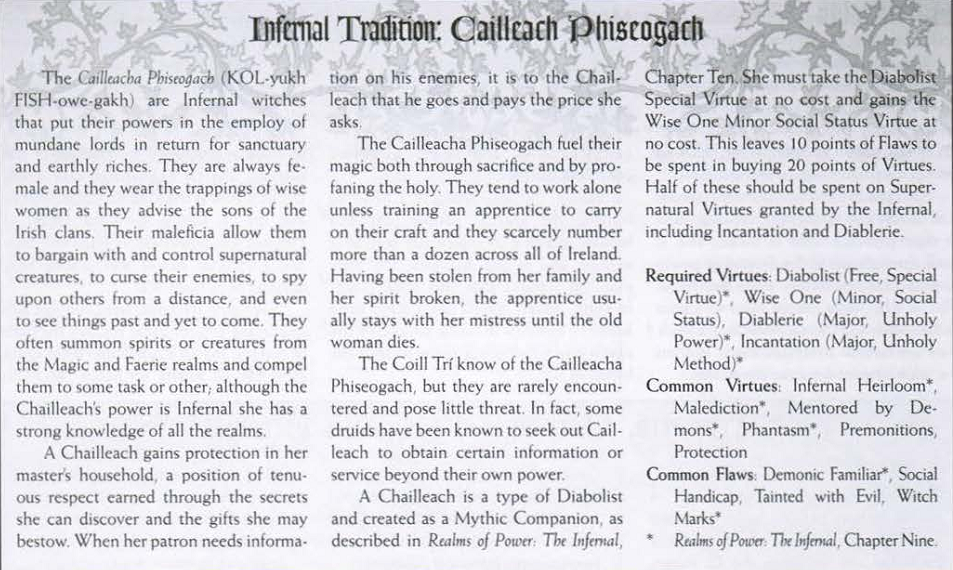
Then, of course, there is the tainted fort of Du Bhun na Gaillimhe in Connacht, at the mouth of the Corrib. It is a naval base to small for large ships, a fort too far to resupply in a siege and a garrison too far from those it protects to do any good. It is always rebuilt and destroyed, offering false hope and easy slaughter. It is often assaulted, and whether the attackers want it or not, the Infernal aids them. Demons break bowstrings or weaken walls, or lead men safely through the marsh around it. This fosters cruelty and despair. History shows that the fort and those settlements it guards will faill to siege again throughout the 1230s as the Normans push west. If the Infernal is not stopped, then it will continue to fall and fail to protect the Connachta.
Perhaps even worse is the island of Inis Doney in Lough Erne of Ulster. It is an island with two natures. For the most part it is a calm place with a Divine aura centered on a beautiful church, which it is said is attended even by angels and saints. But there is a place on that island where no angel or saint will even look. Beyond the church is a stoney track heading down to a barren, quiet and cold place. This area has a weak Infernal aura and is the entrance to a series of Infernal regiones which grow darker and more evil as you head down. If you somehow manage to walk the path all the way to the very edge of Hell itself, then return to the church on Inis Doney, no demon may ever again tempt you, posess you or stay under your roof.
The End!